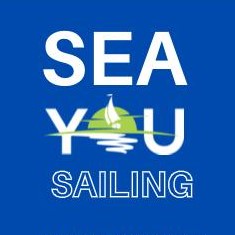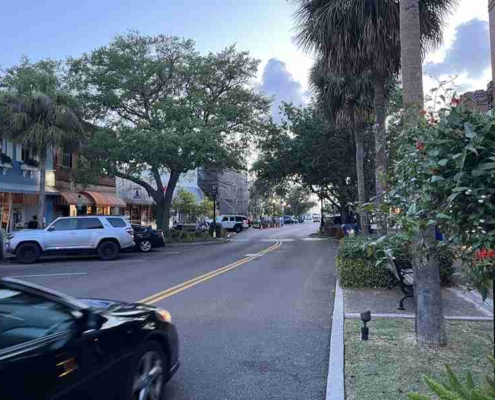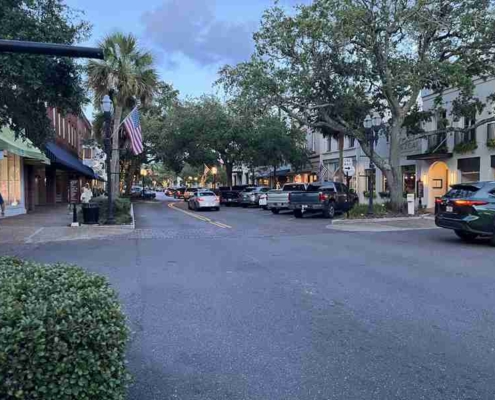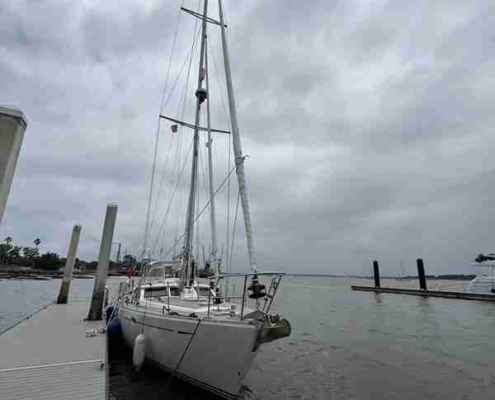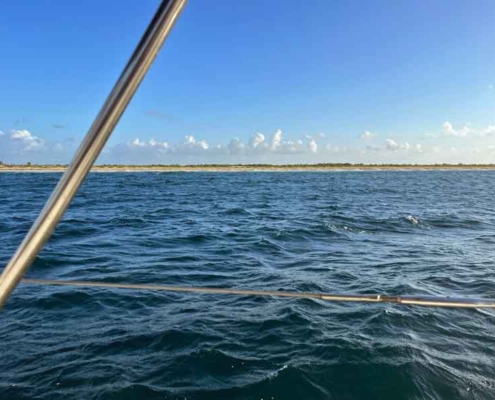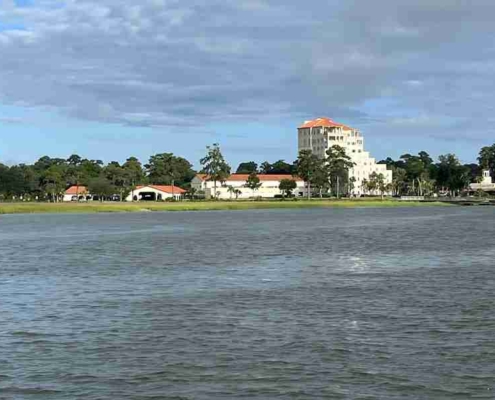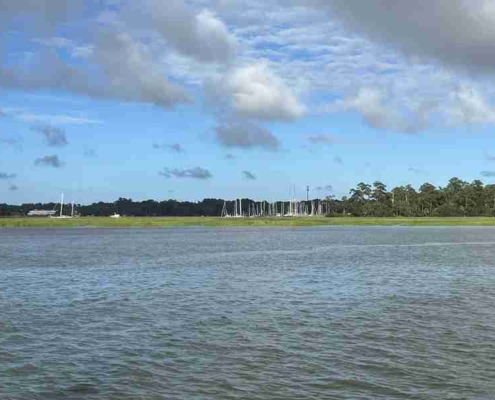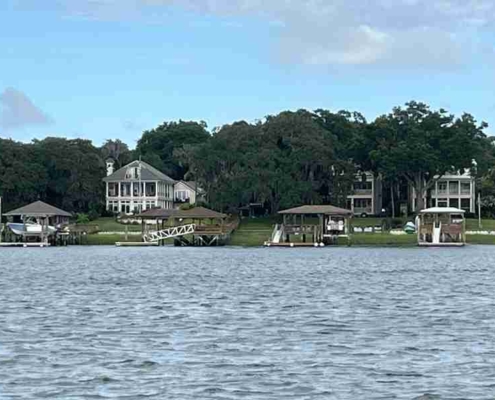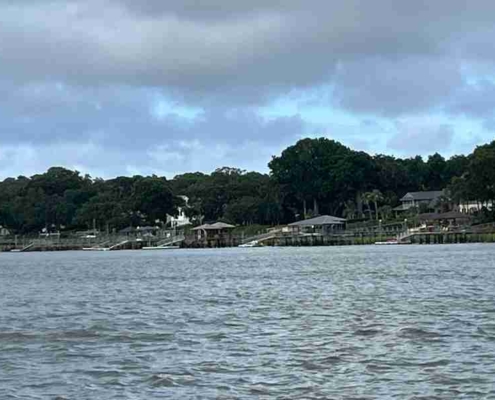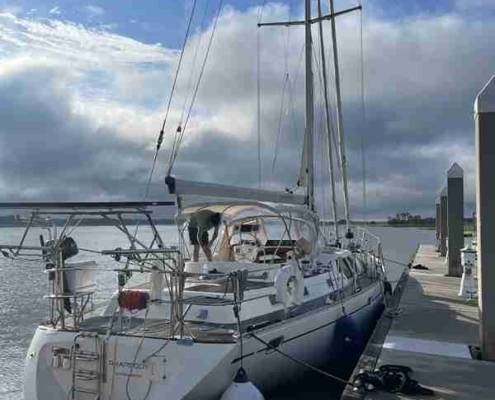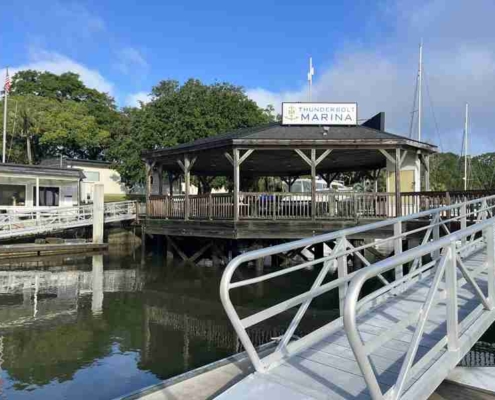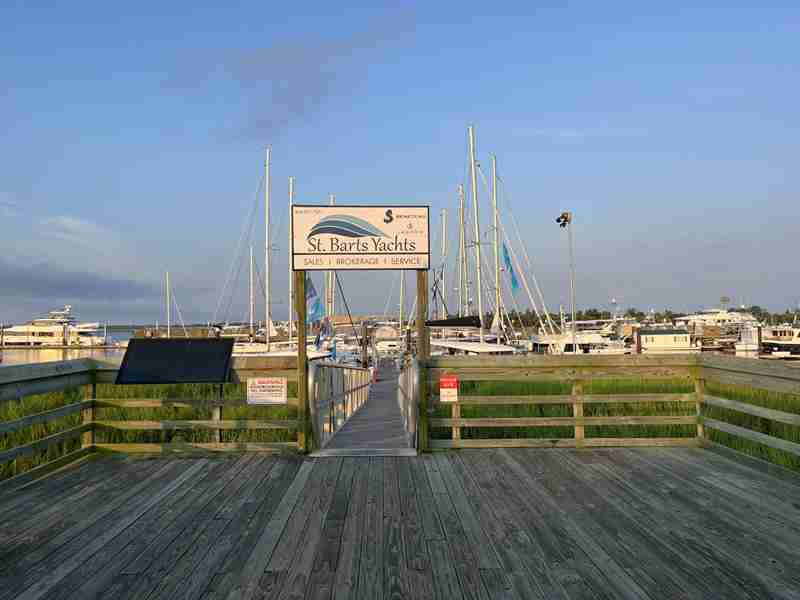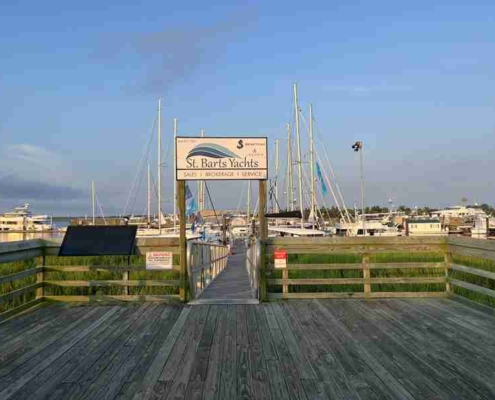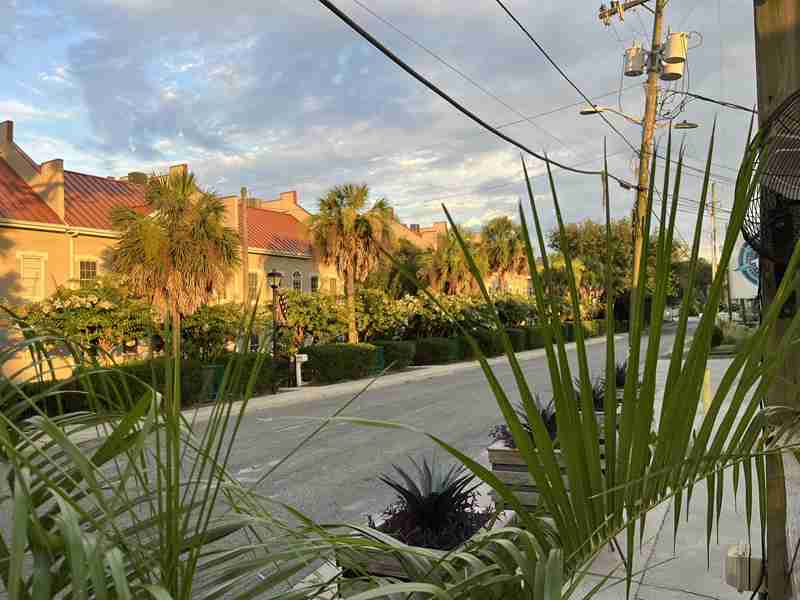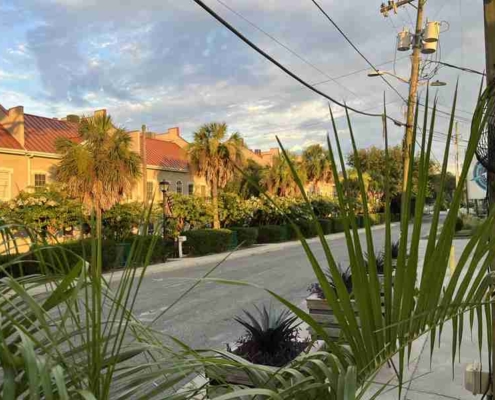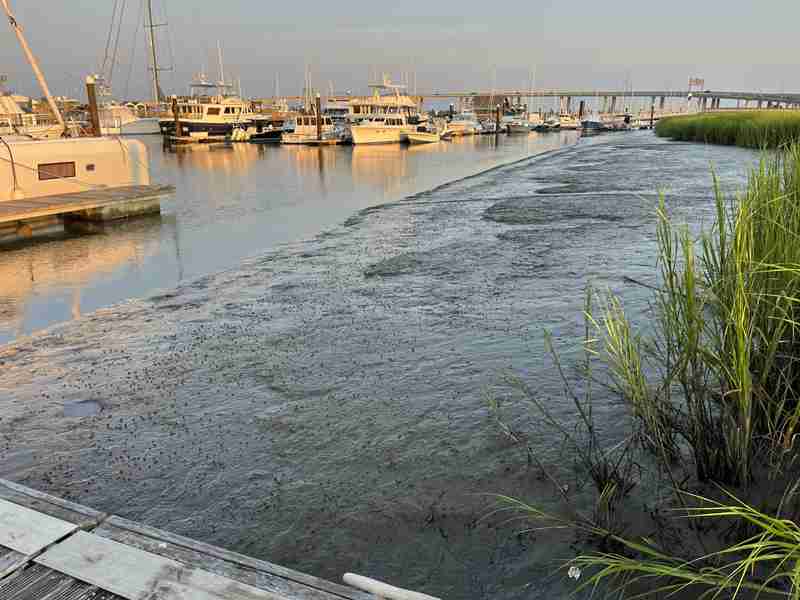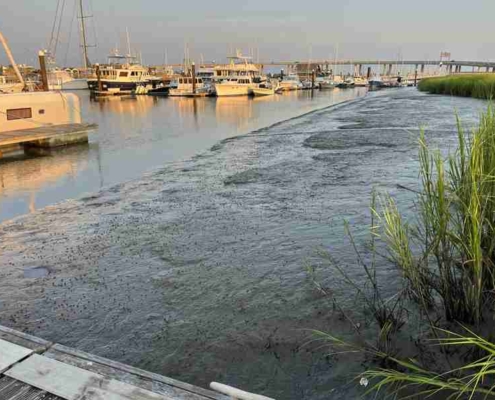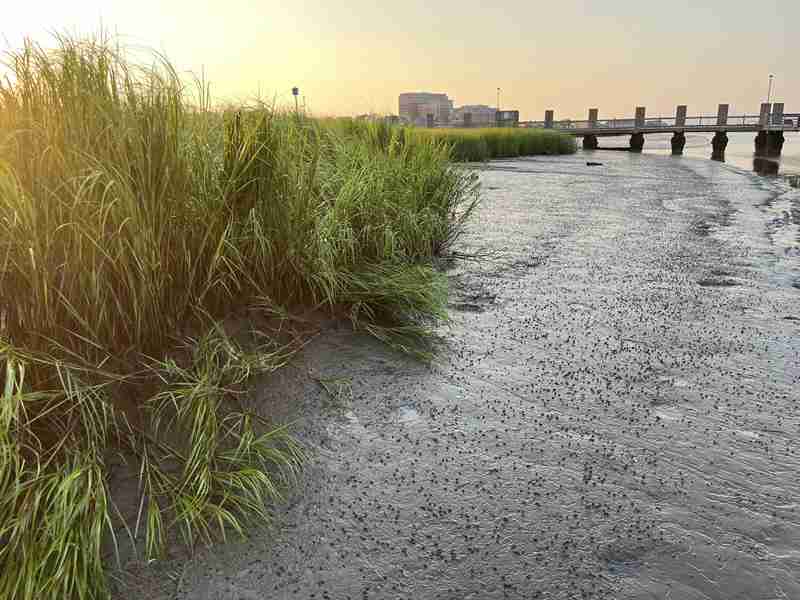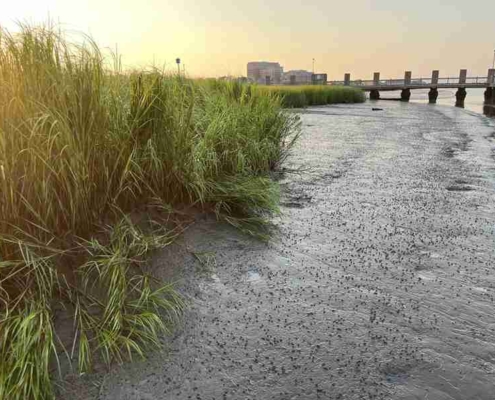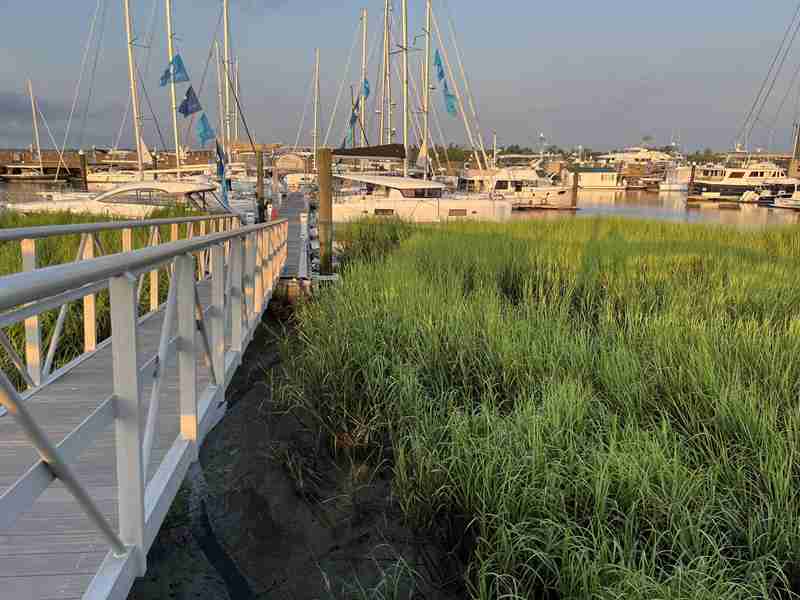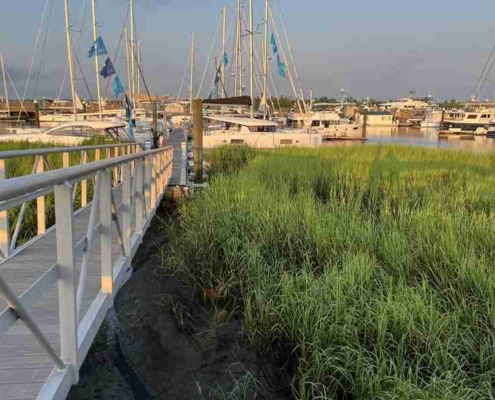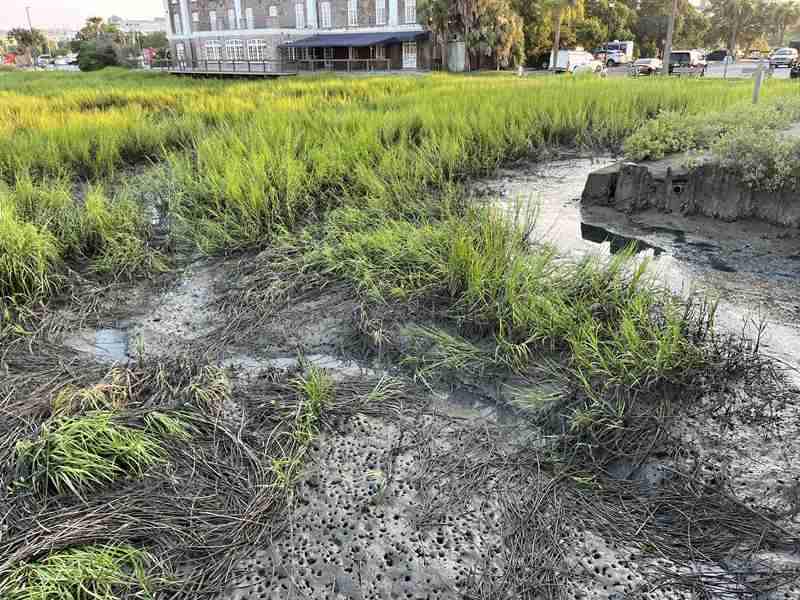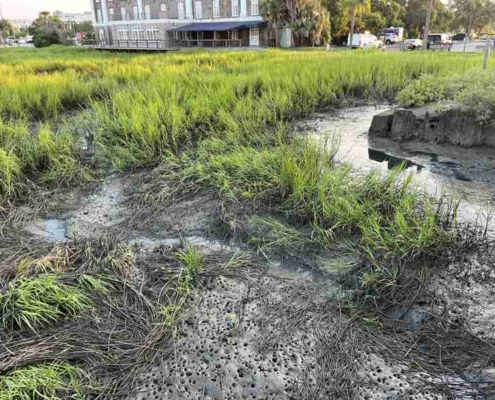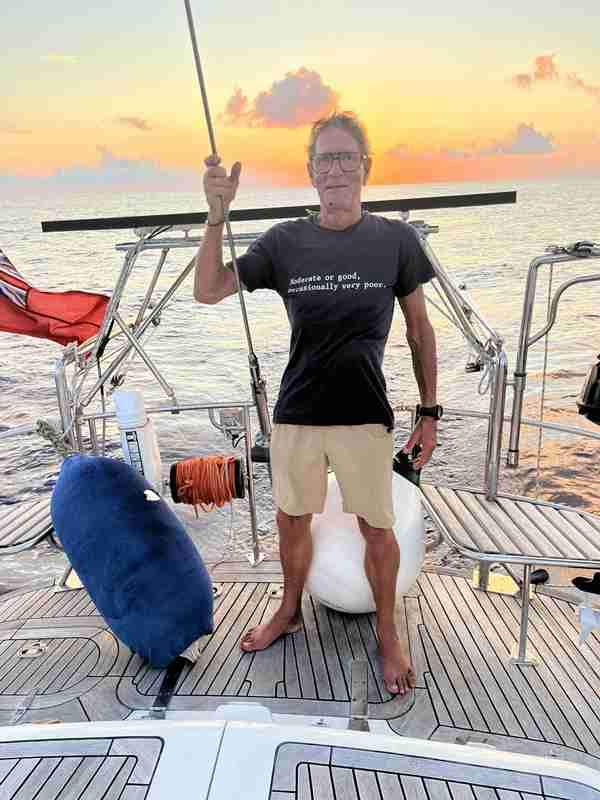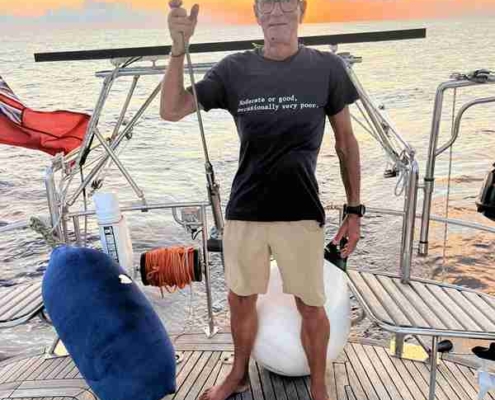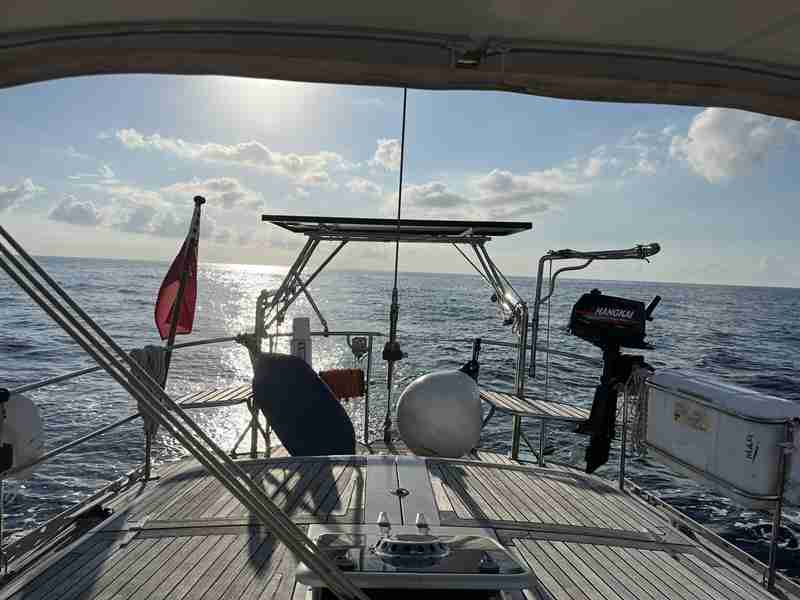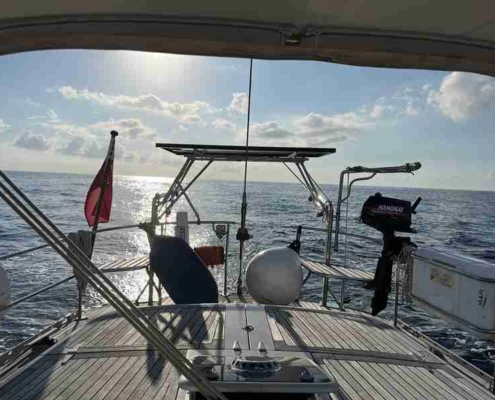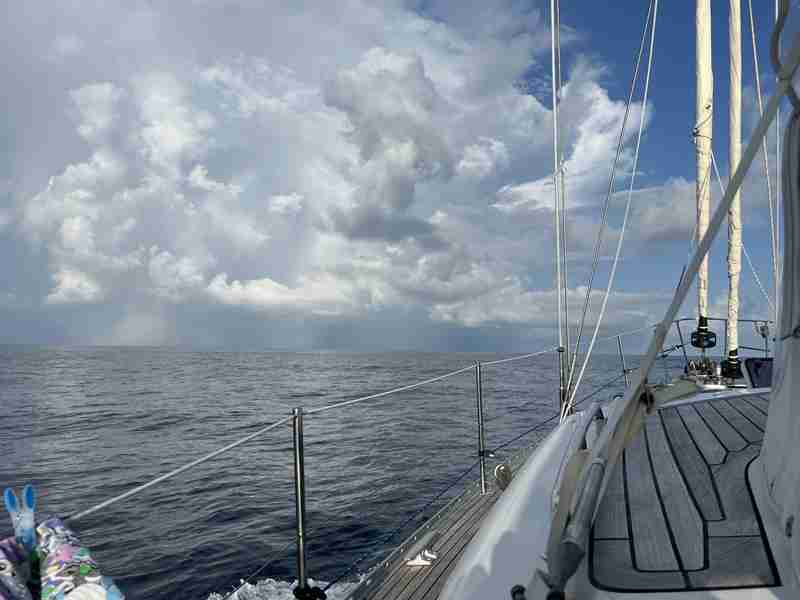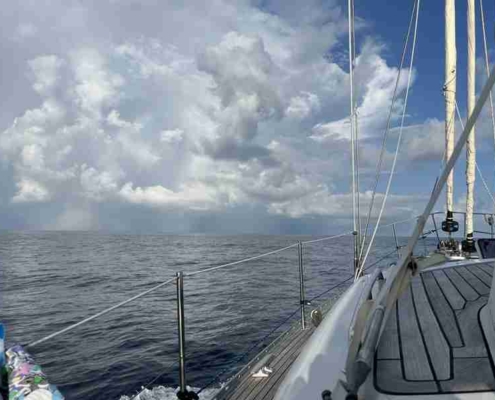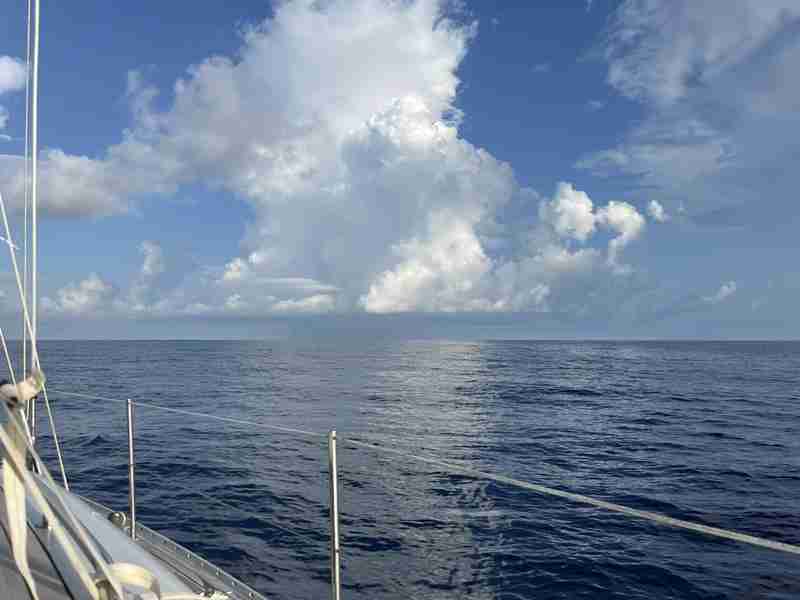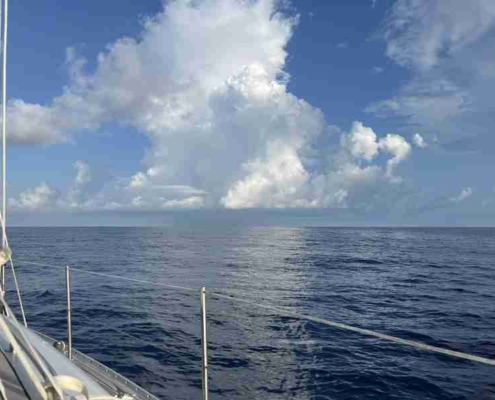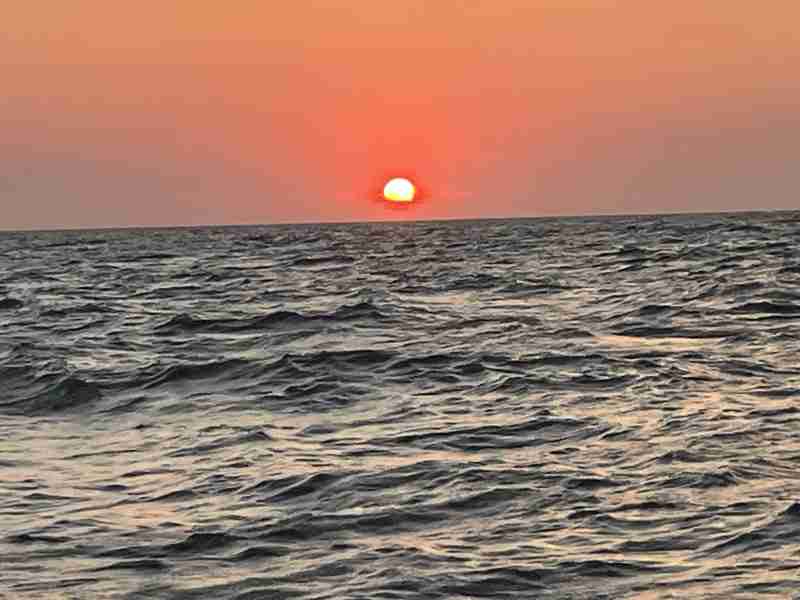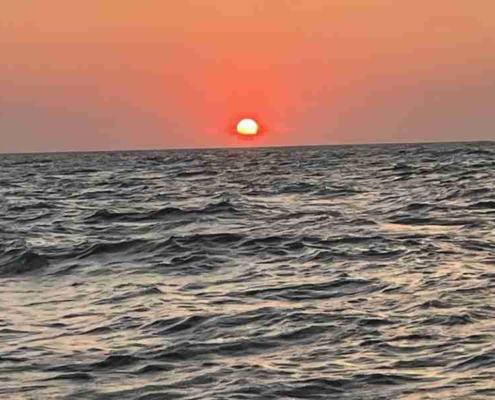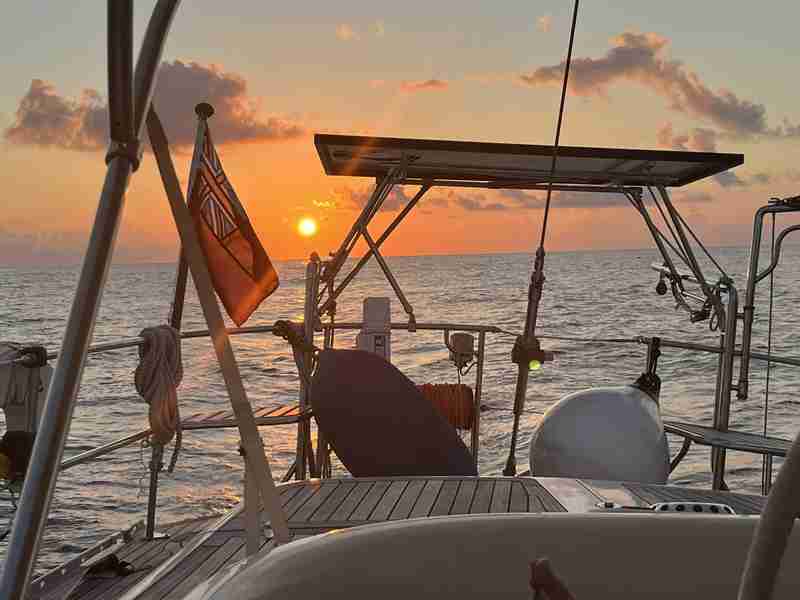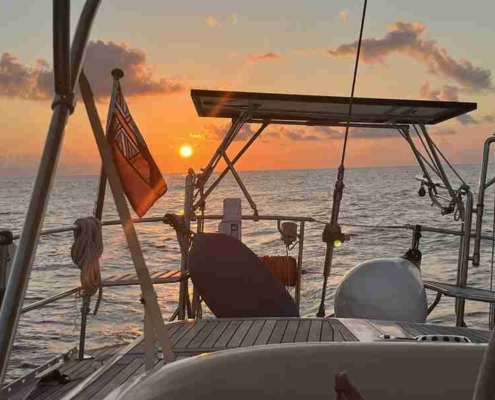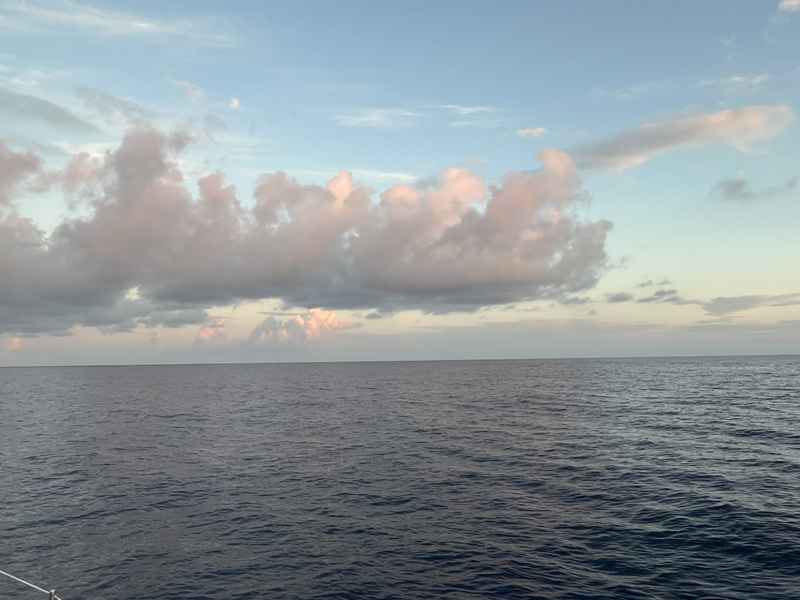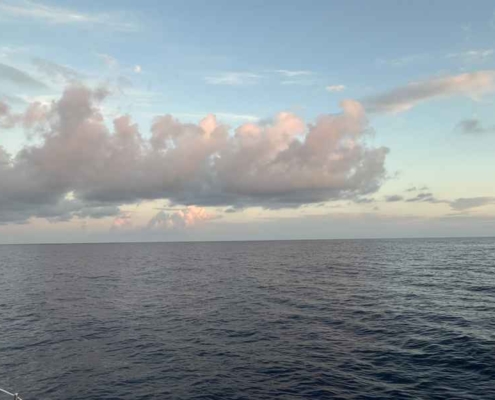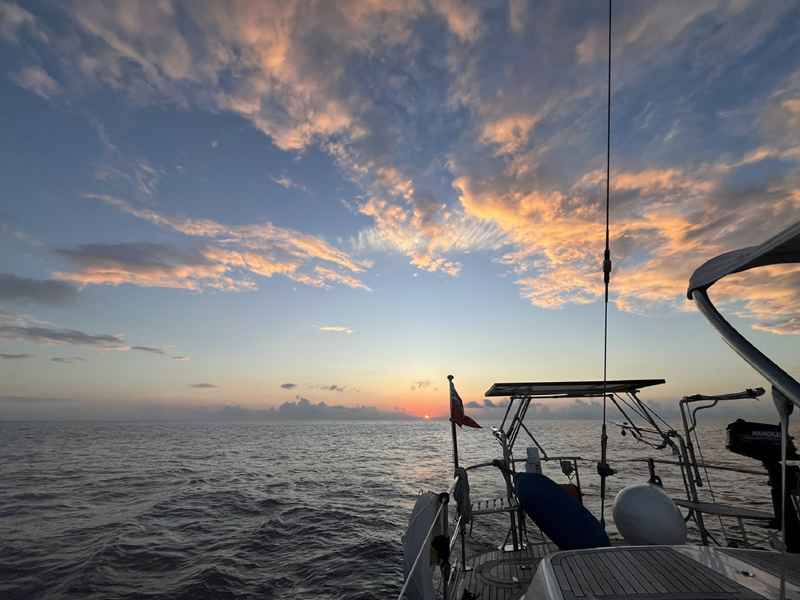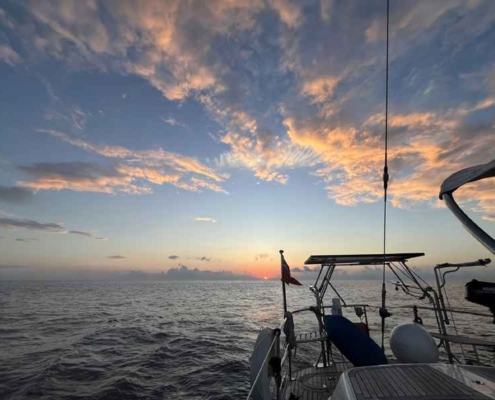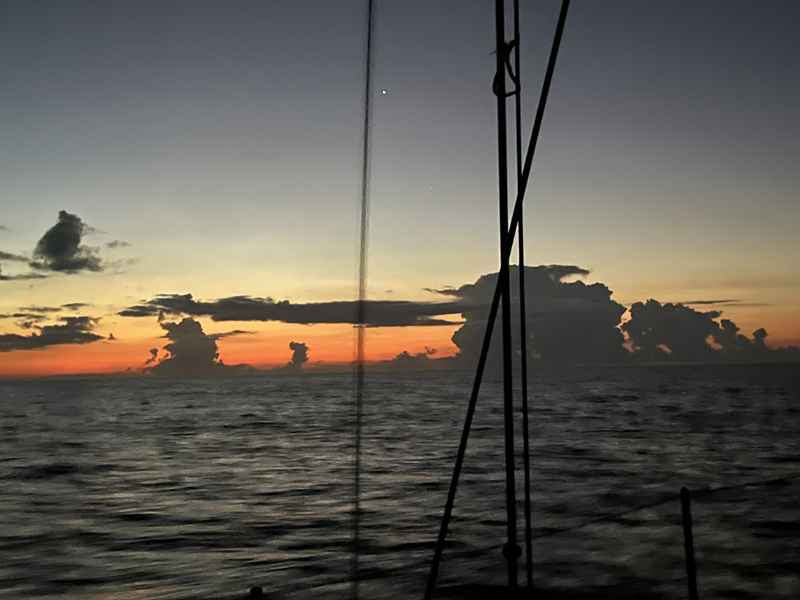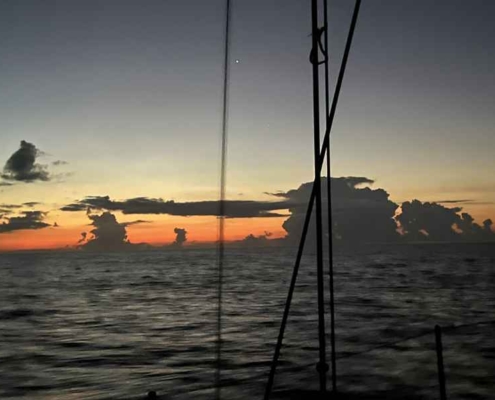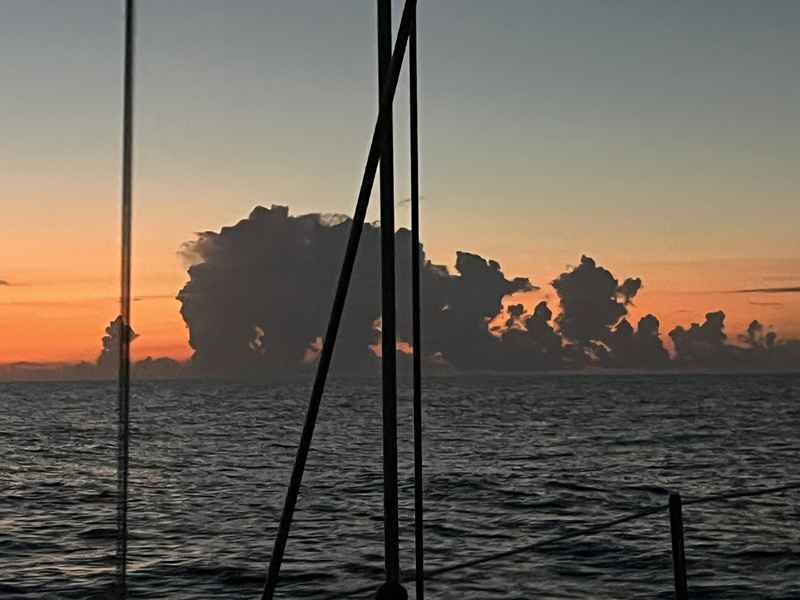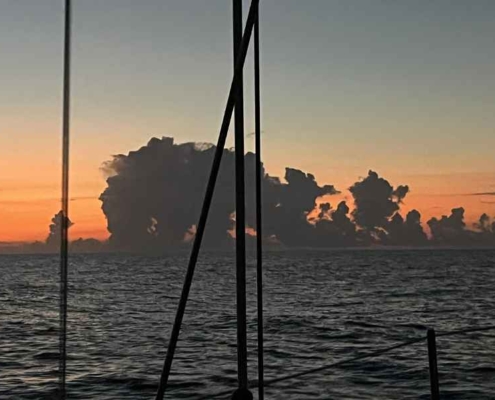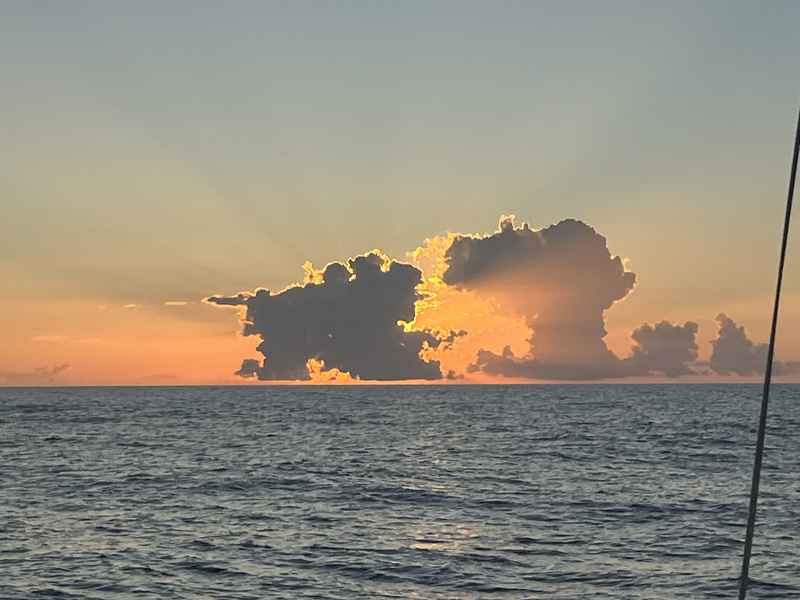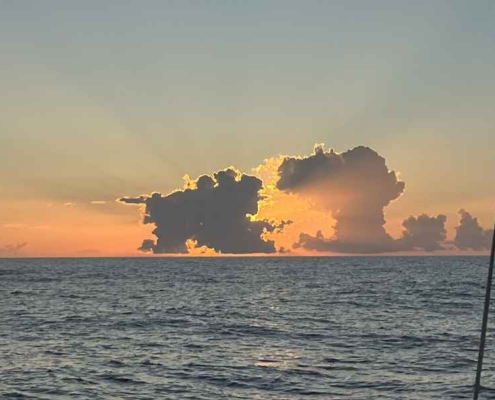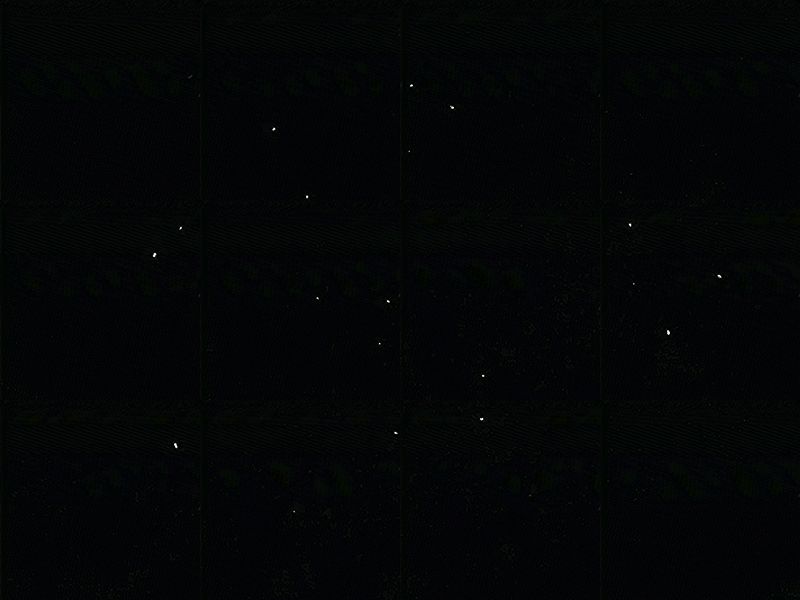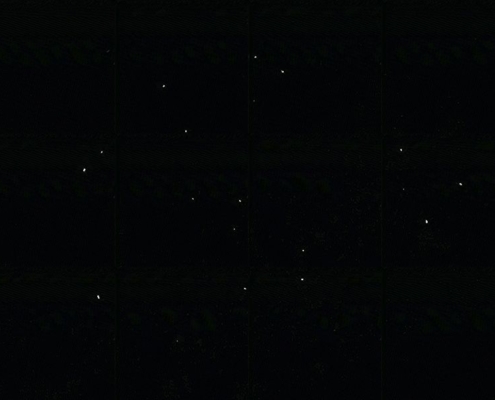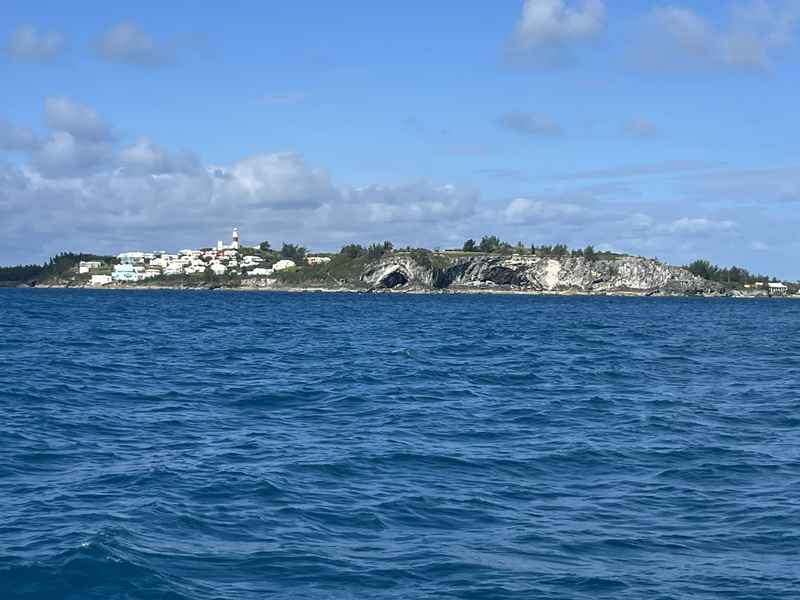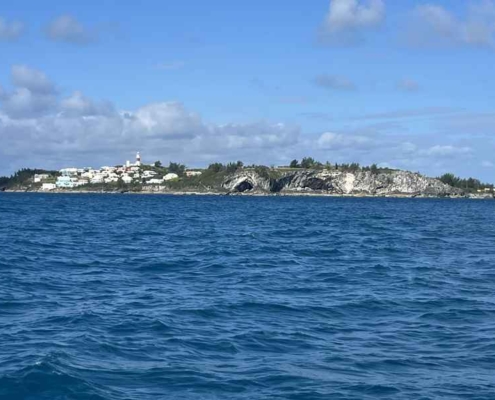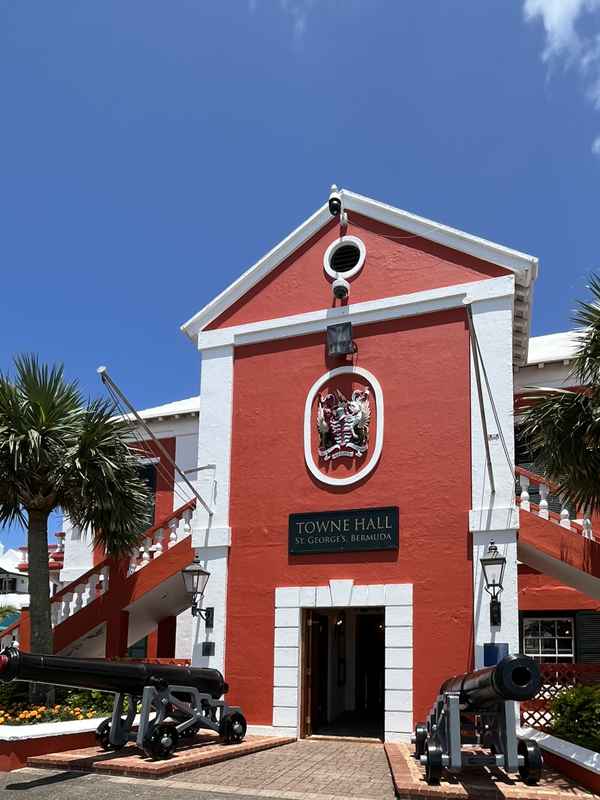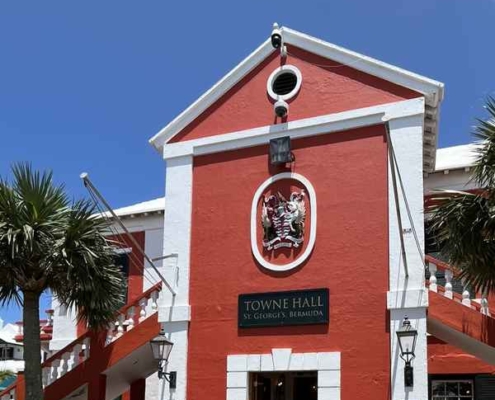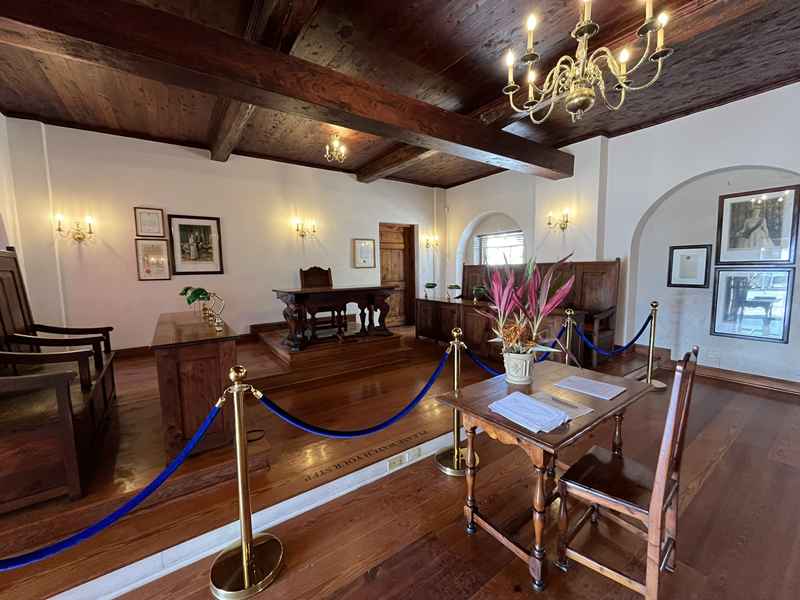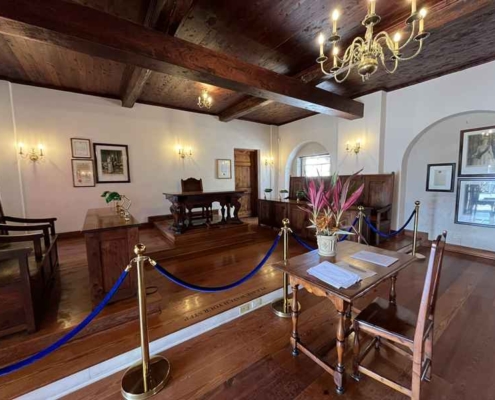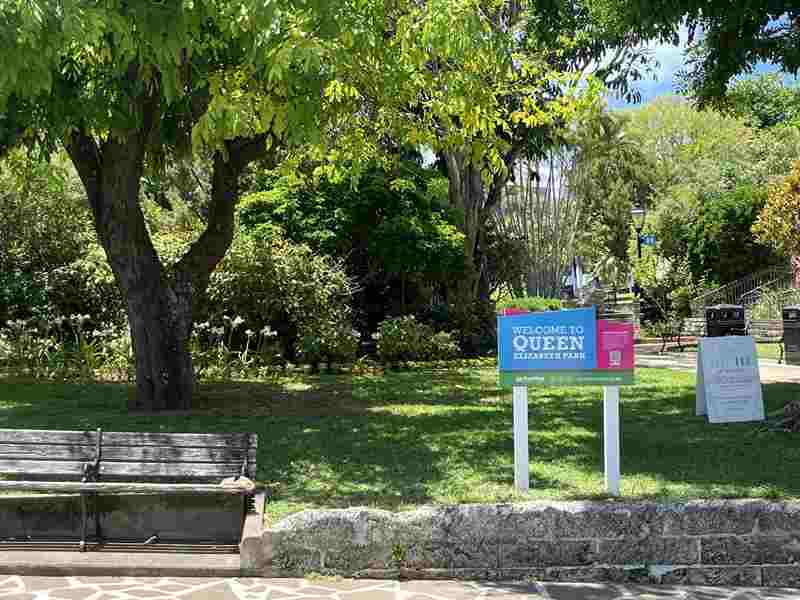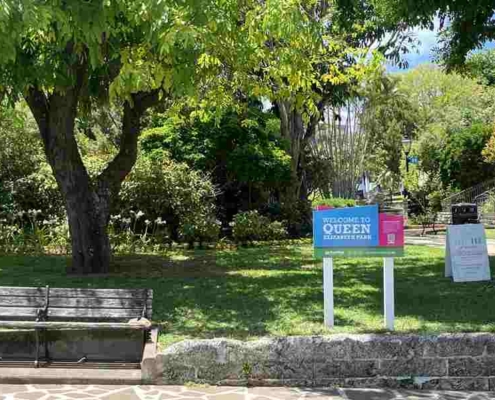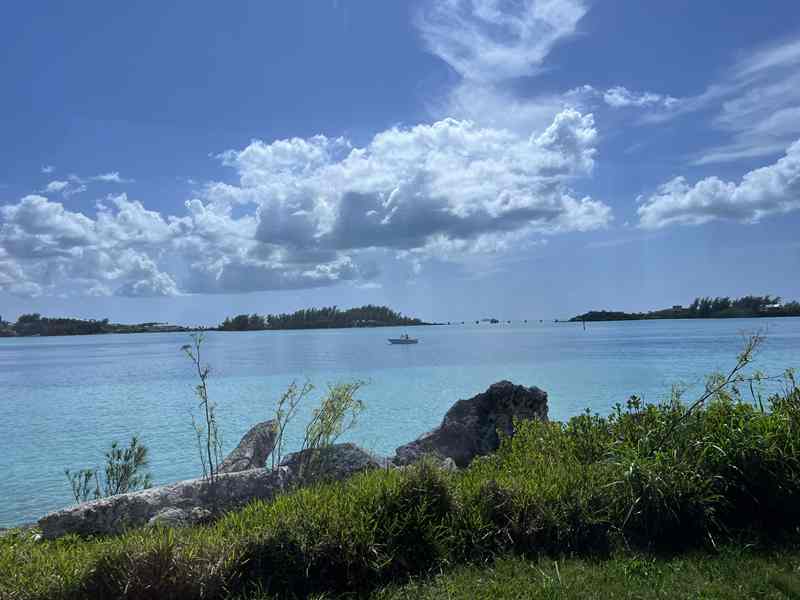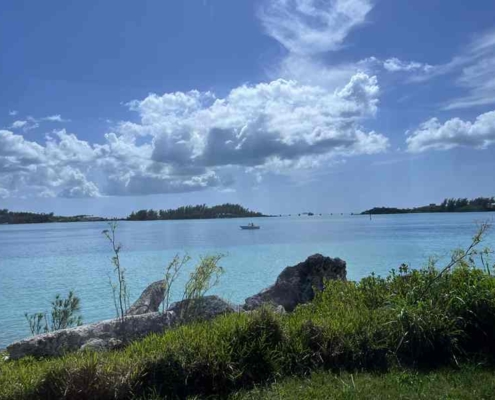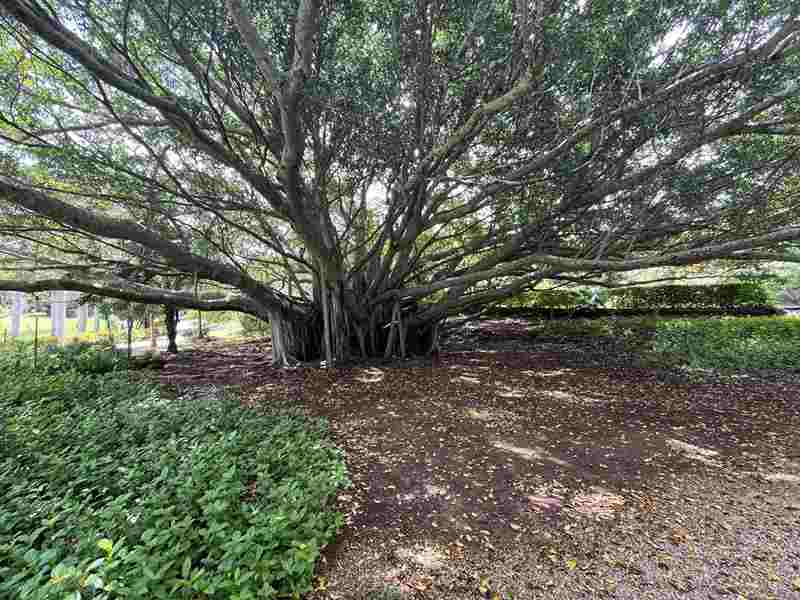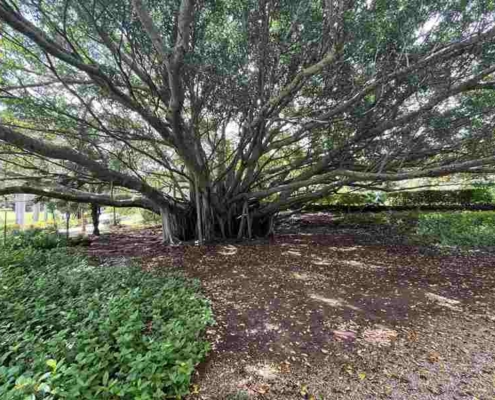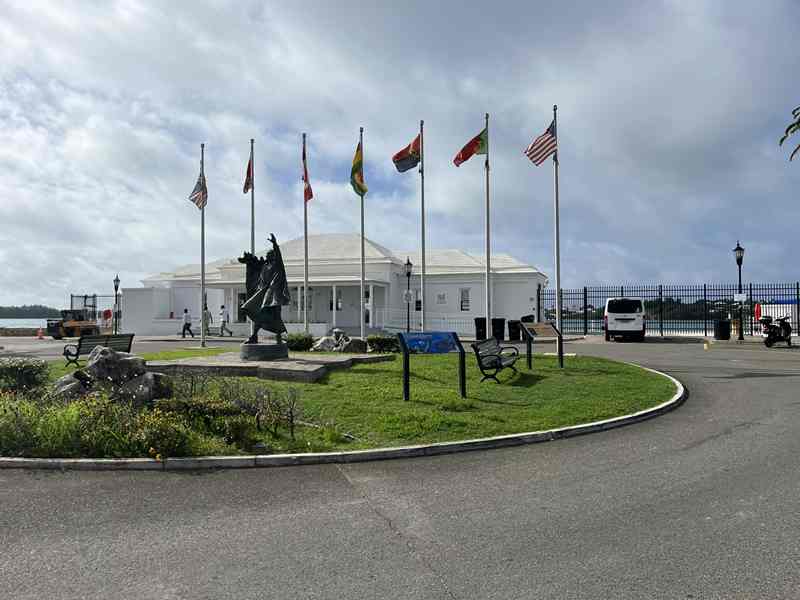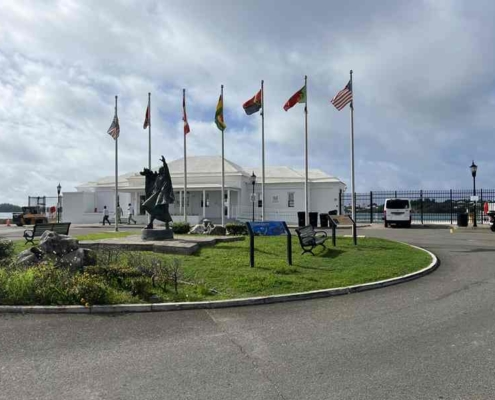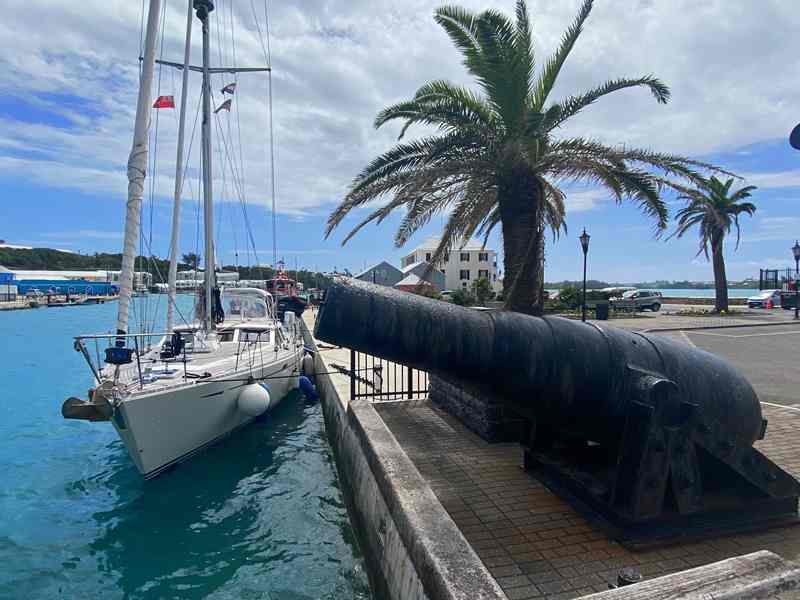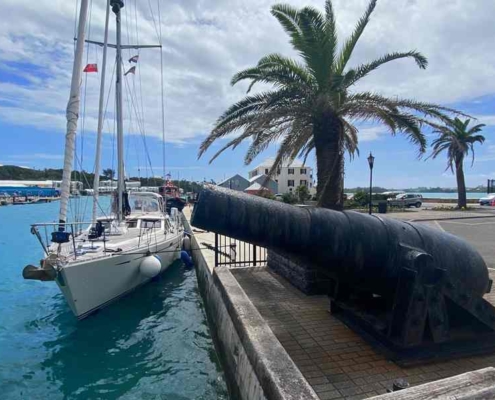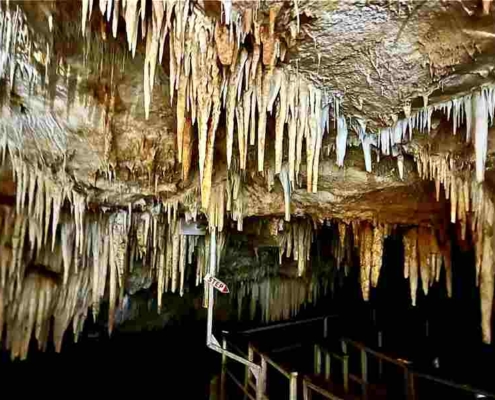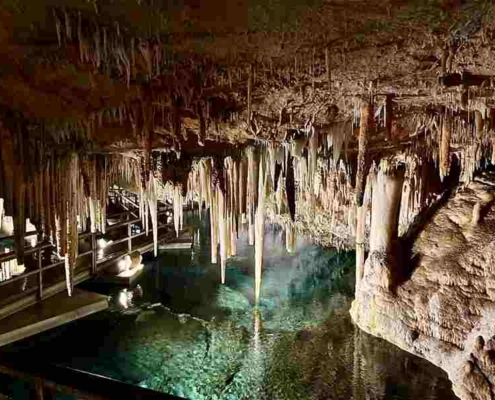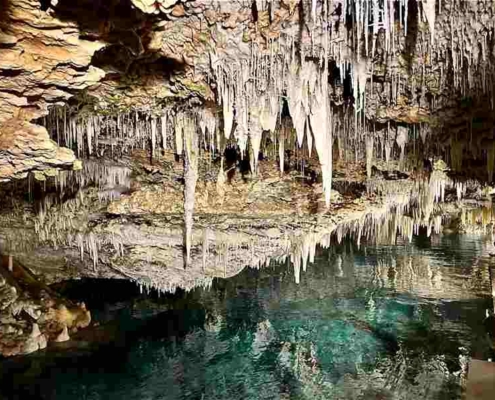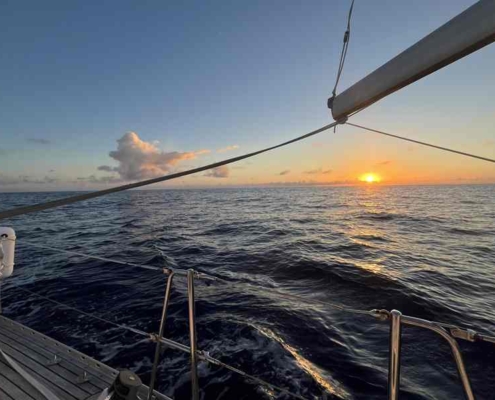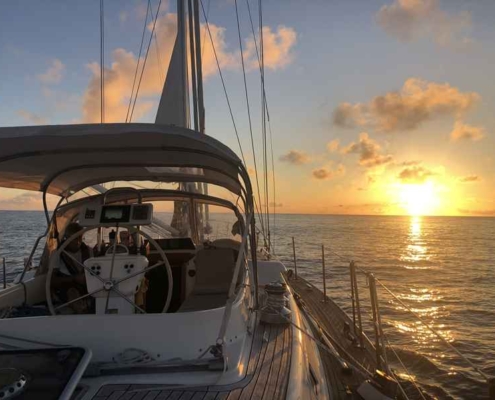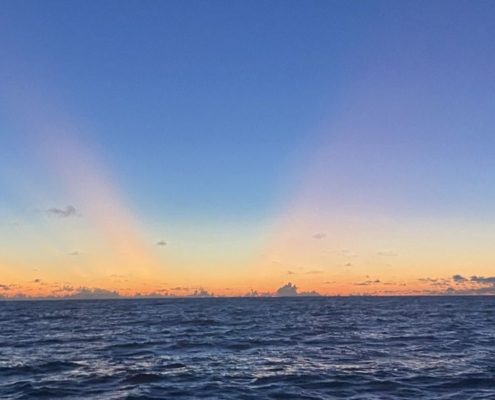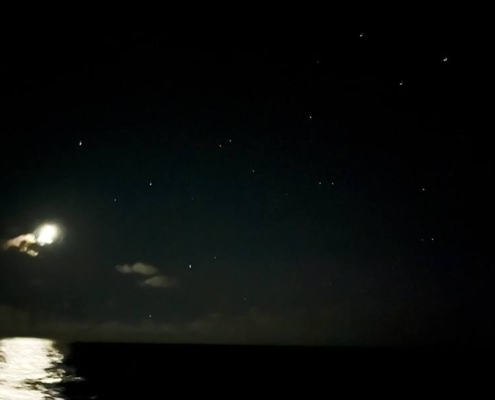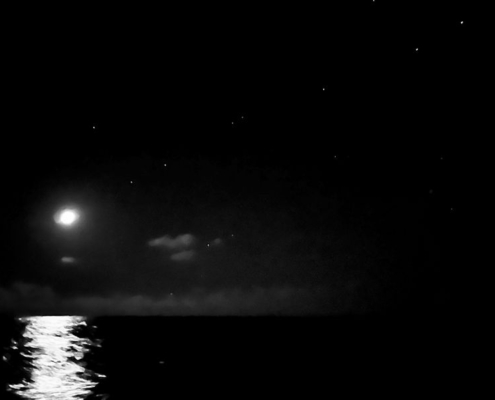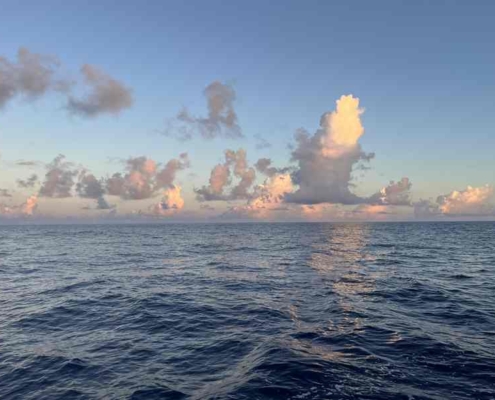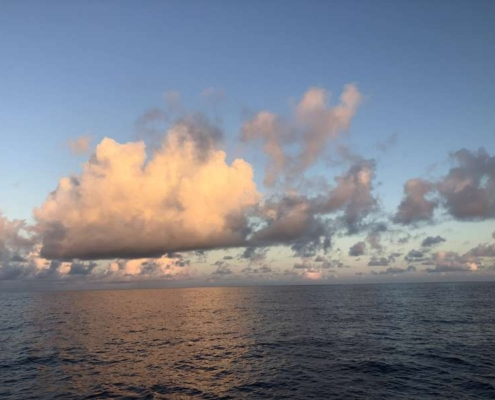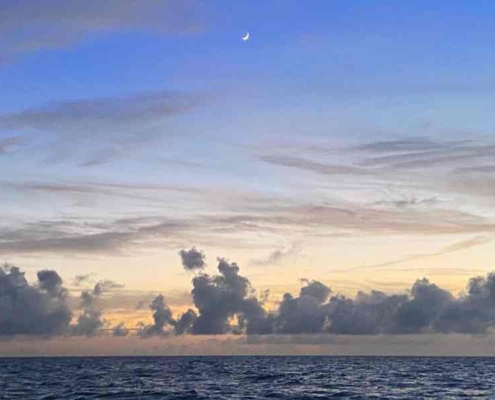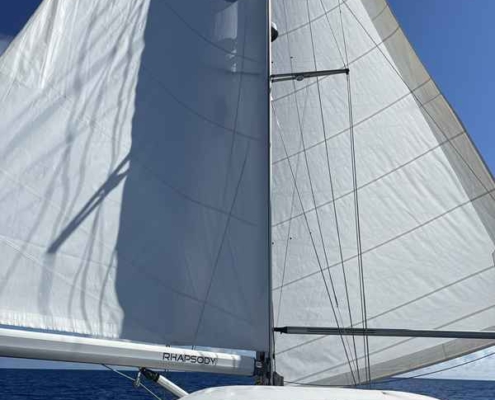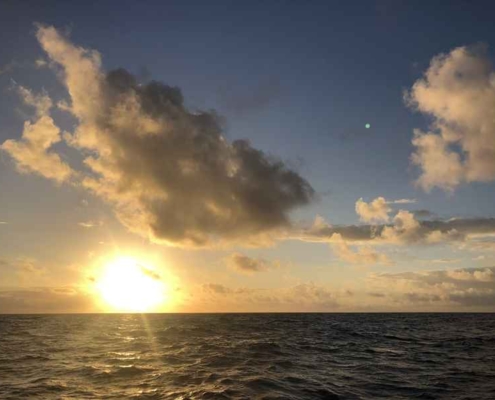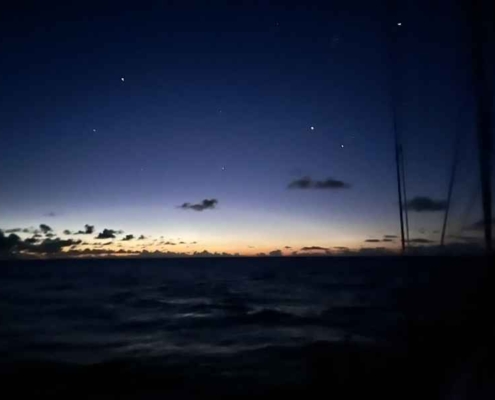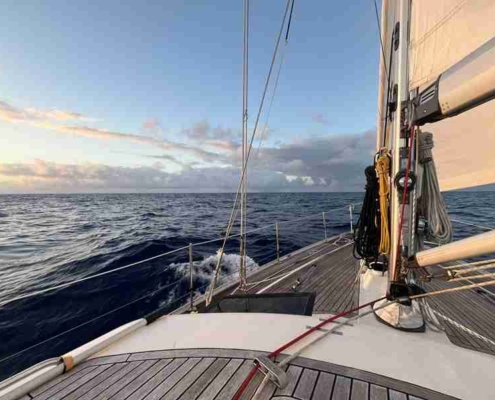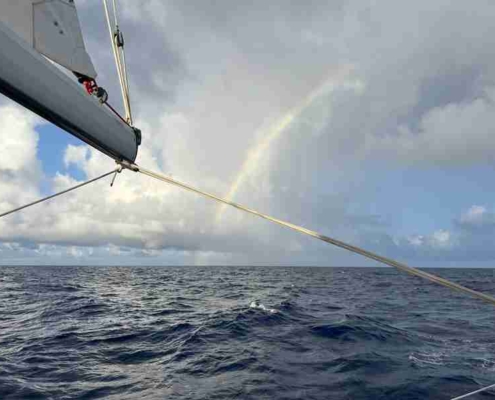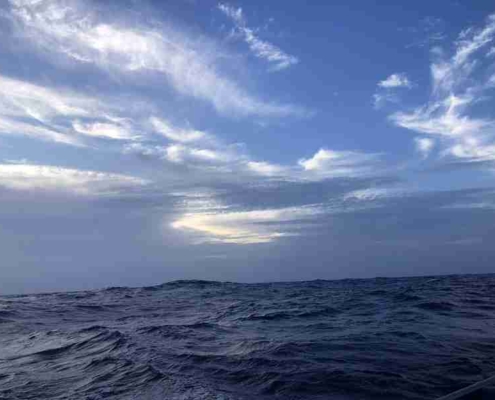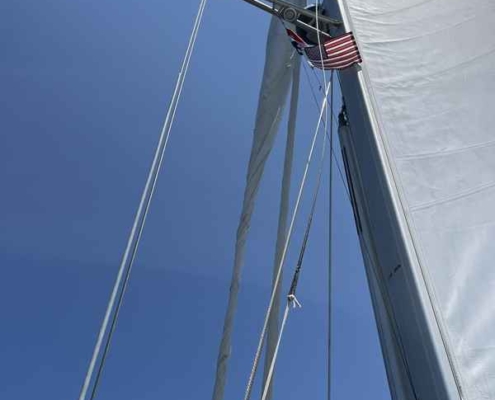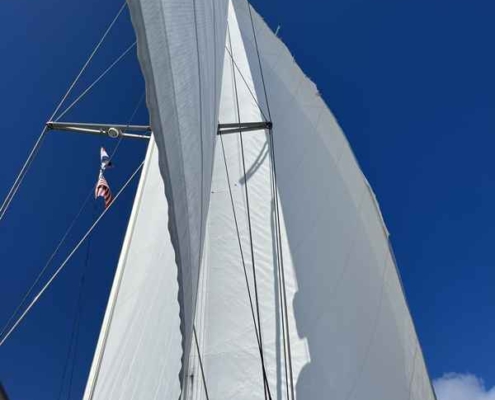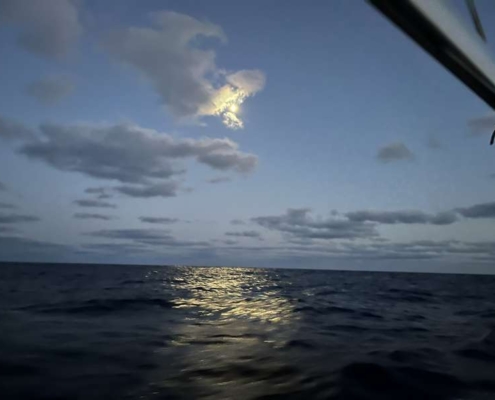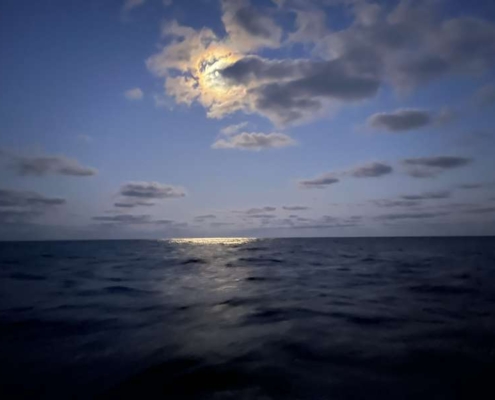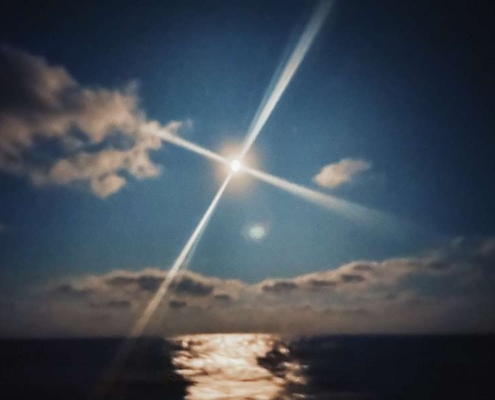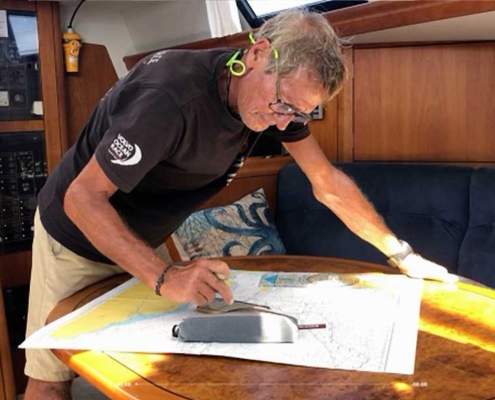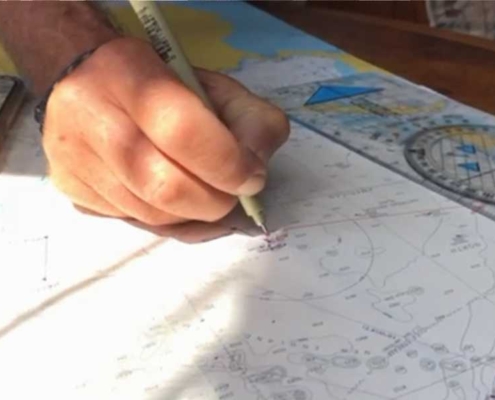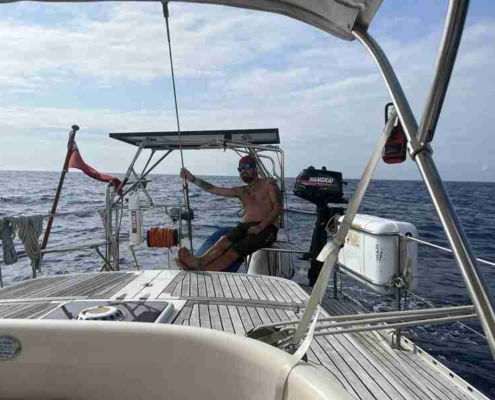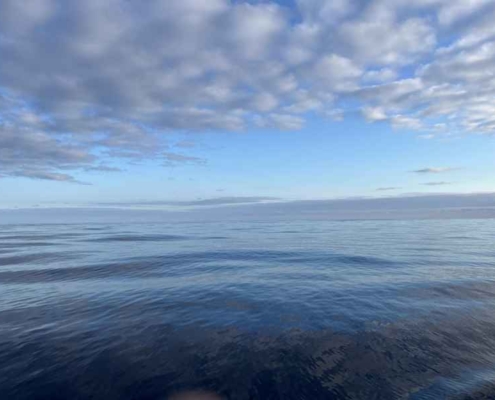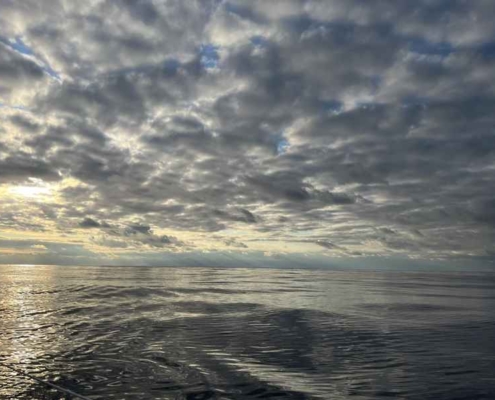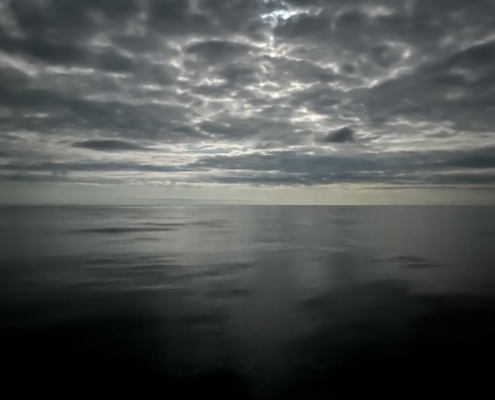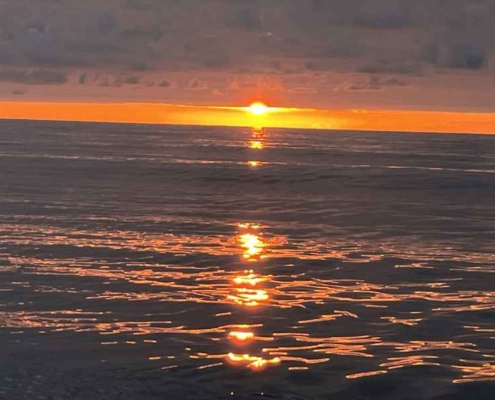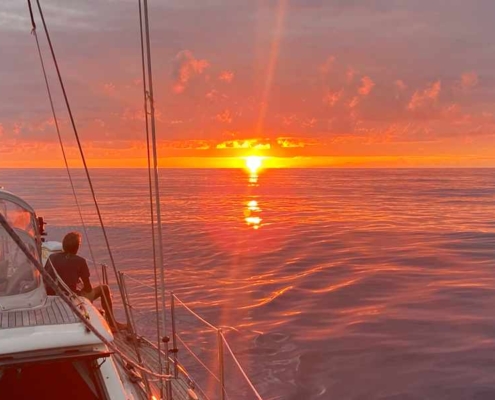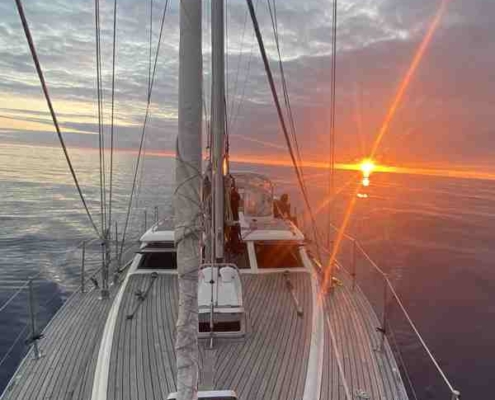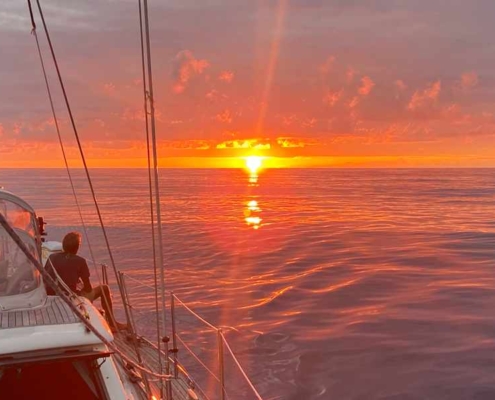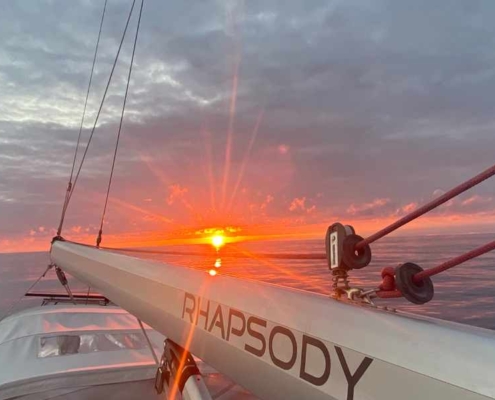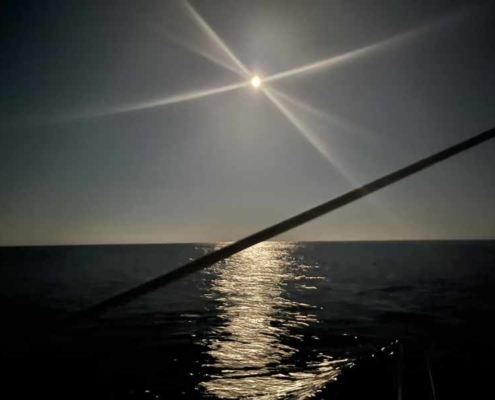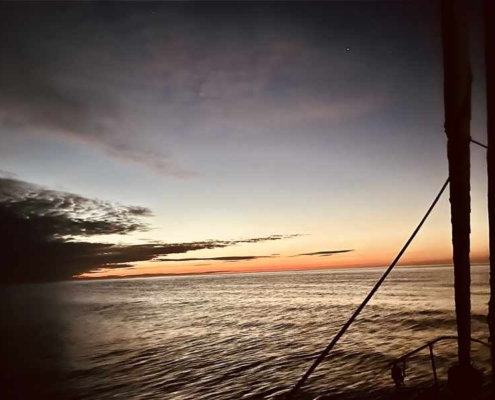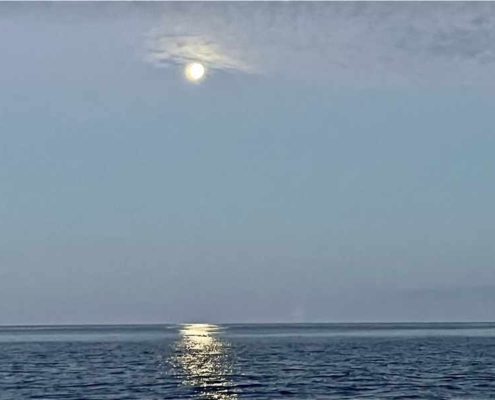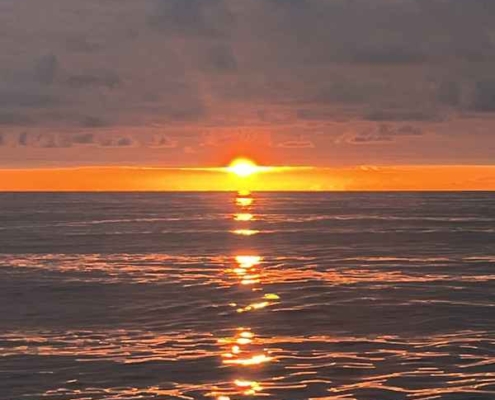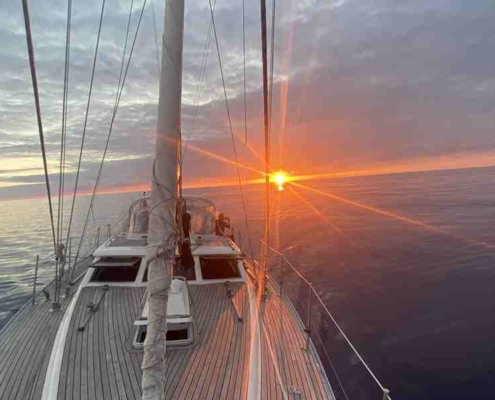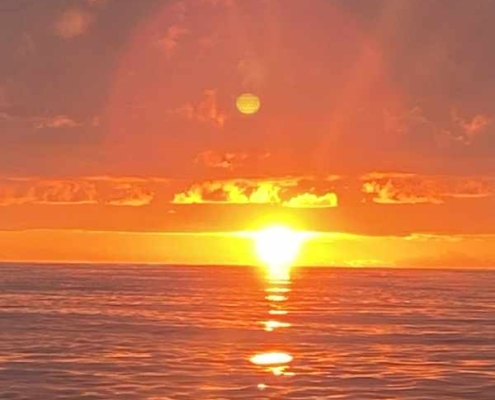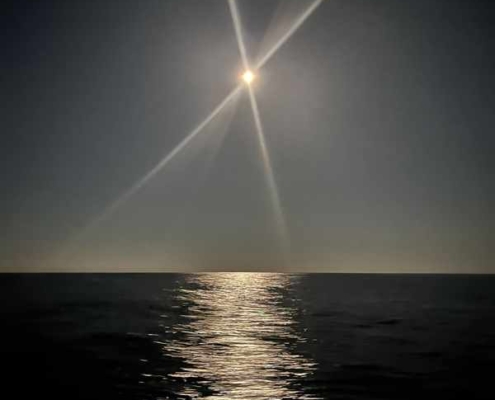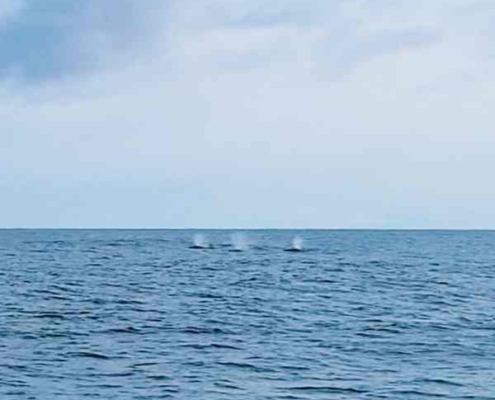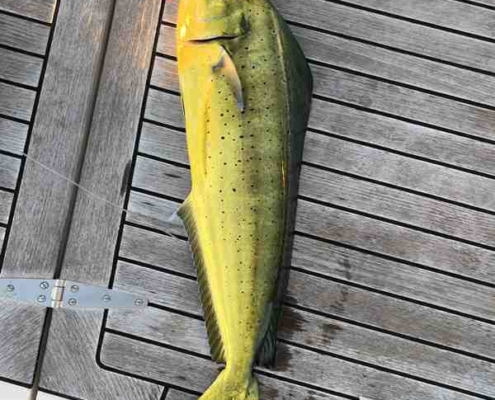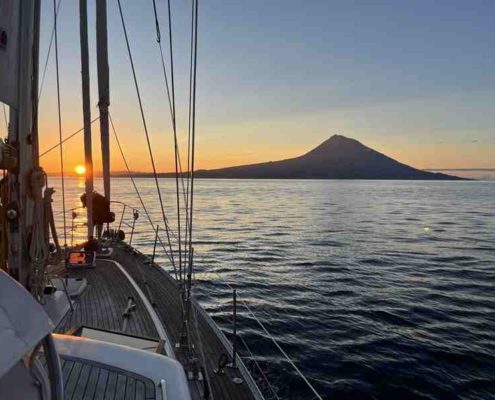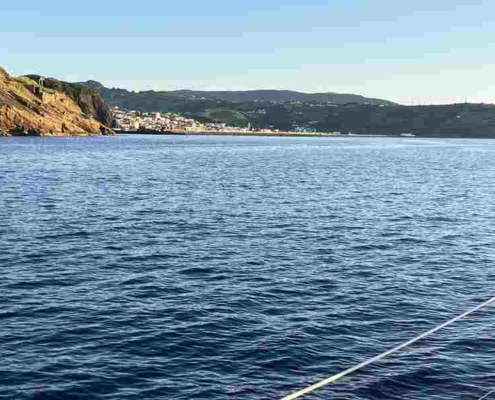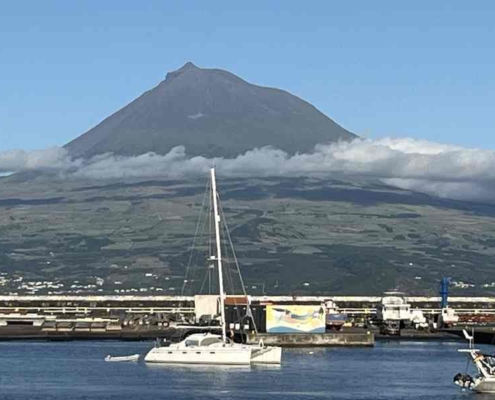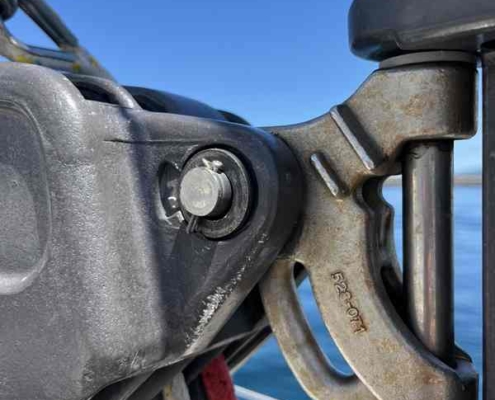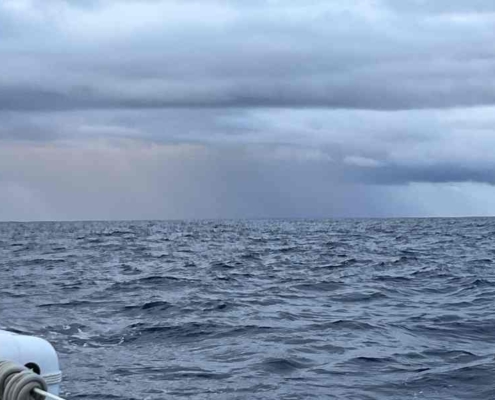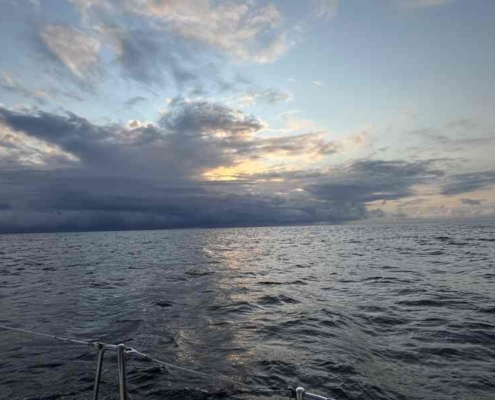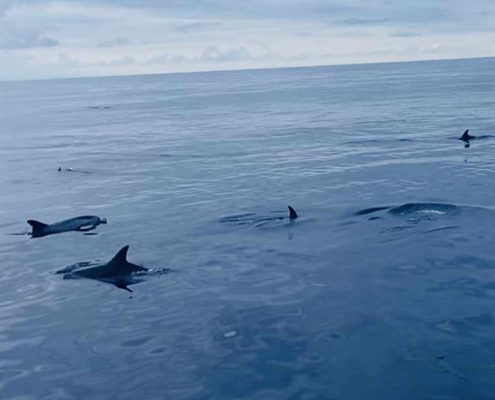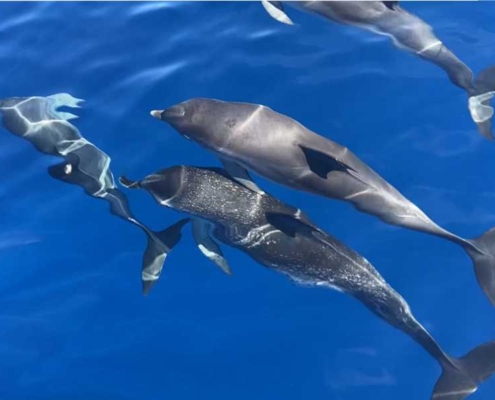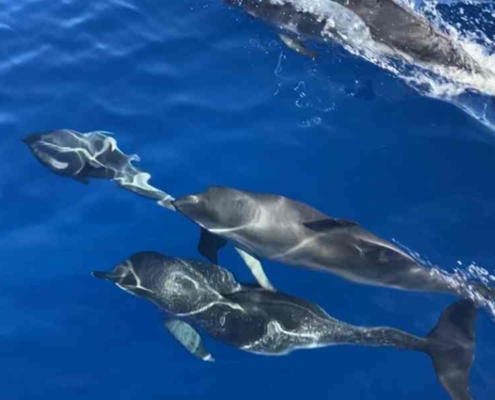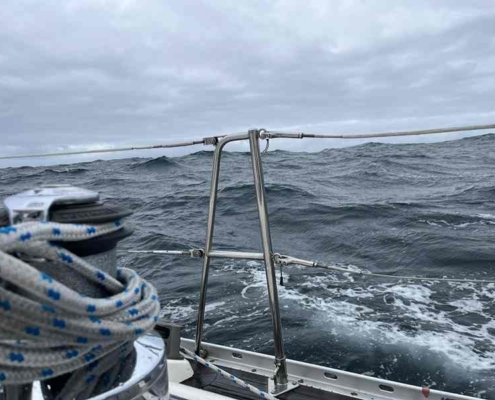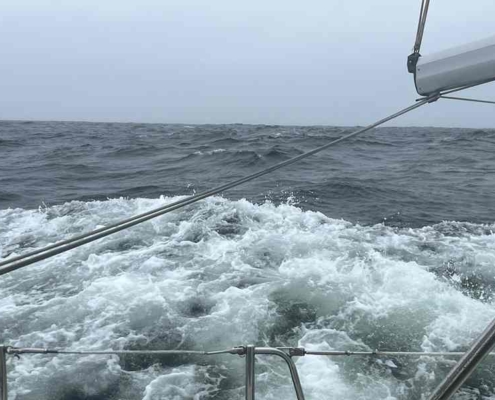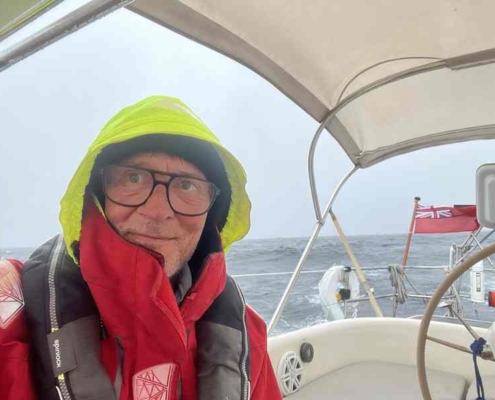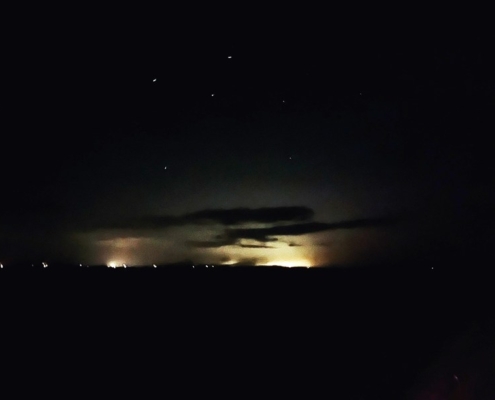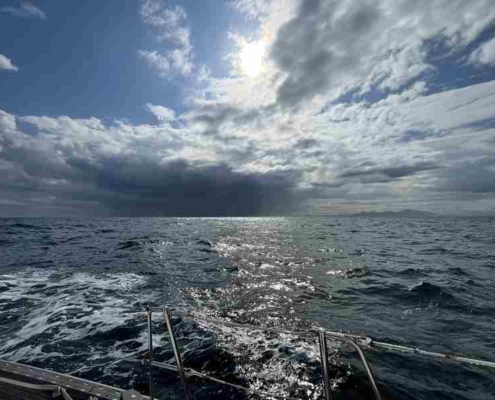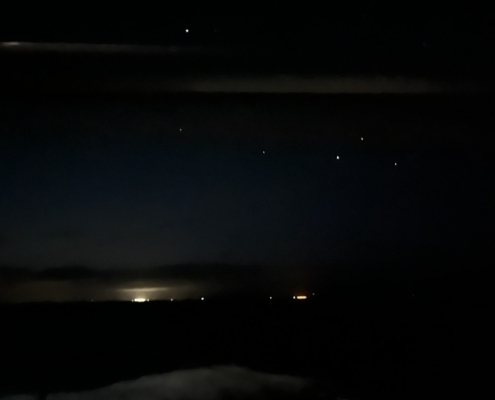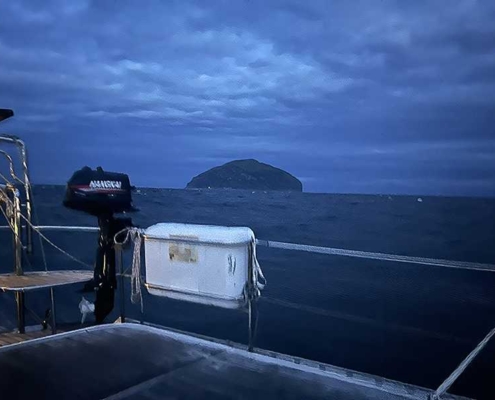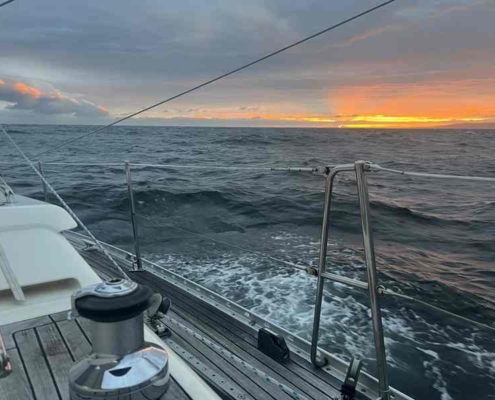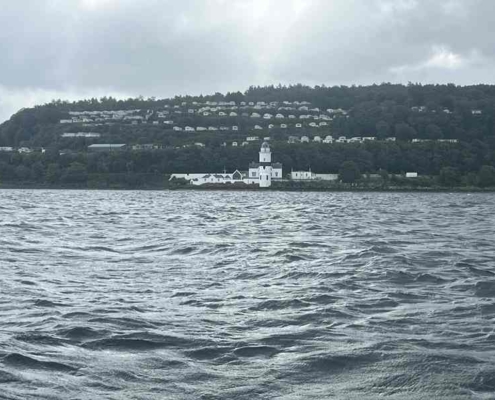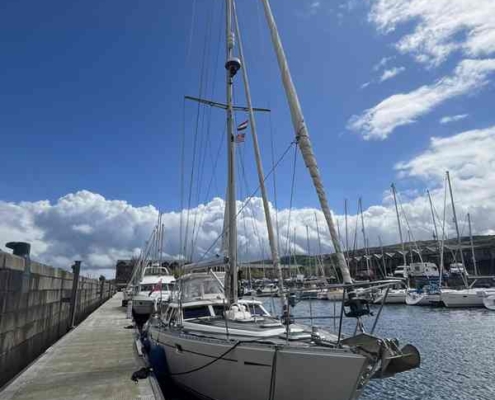Rhapsody, an Oyster 485, Fernandina, Florida US – Greenock, Scotland June – August ’24
Crossing the Atlantic eastbound with a detour to Bermuda and the Azores
Wednesday, June 18 – Arrival in Jacksonville
Early in the morning, I flew via Atlanta to Jacksonville. Upon arrival, I quickly found Matt and Guy, my crew for this trip. We took an Uber to the marina where the boat was supposed to be docked. However, it turned out that we had been given the wrong marina. So, we headed to Tiger Point at Fernandina Beach. And there she was—a beautiful boat, from what I could see. After settling in a bit, we decided to go grab something to eat.
Friday, June 20 – Departure from Tiger Point Marina
The next morning, we thoroughly inspected the boat and checked everything necessary.
The engine had just received a full service, and everything seemed fine—except for the stop button, which wasn’t working. We had to shut off the engine on the engine itself. Not ideal, but manageable. Oh, and the sink’s wastewater pump wasn’t working properly either, so we had to use a dishwashing bowl and empty it overboard—not exactly convenient.
That afternoon, we did the provissioning, and the rest of the day was spent organizing and storing allthe stuff.
On Friday afternoon, we left with high tide. Initially, the weather was nice, but it changed quickly. Thunderclouds started forming all around the boat. When we tried to reef, we discovered that the furler wasn’t working properly—the furling line was slipping on the drum.
That was a real problem. I managed to furl the sail using the winch handle, but I wasn’t comfortable crossing the ocean like that. A thicker line might have helped, but upon closer inspection, the drum’s teeth were completely worn down. This needed to be fixed. We decided to head for Savannah, where Thunderbolt Marina had a shipyard that might be able to help.
Wednesday, June 26 – St. Barth’s Marina, Charleston
We arrived at Thunderbolt Marina on Saturday evening. The shipyard was closed on Sunday, but I was able to submit a service request at the marina office.
On Monday afternoon, a technician came to inspect the issue. He assured me that someone more experienced would check it out the next morning. That person did show up but couldn’t promise anything regarding the timeline.
Meanwhile, Tiger Point Marina had given me the contact information of someone in Charleston who could definitely help and was available. That was ideal, as Selden, the furler manufacturer, was also based in Charleston, so getting new parts wouldn’t be a problem. We left immediately and arrived there on Wednesday morning after a beautiful passage.
They were already waiting for us and managed to fix everything that same day—by installing a brand-new unit. Perfect. We decided to depart the next day.
Friday, June 28 – Position 32:81.237N 075:13.291W
Not long after leaving Charleston, a new problem arose: the oil pressure dropped into the red zone.
At Tiger Point, I had picked up a spare can of oil for both the engine and gearbox, along with filters and an impeller—just in case.
After topping up, the pressure stabilized for a while but then dropped again. That wasn’t good. I only had picked up one gallon of oil and now it was almost gone now.
I decided to divert to Bermuda to get more oil. It remained completely unclear where all that oil had gone—no leaks under the engine, no blue smoke no nothing.
Wednesday, July 3 – St. George’s, Bermuda
We had a beautiful sail to Bermuda. However, once I announced we would stop there, Guy informed me that he wanted to leave the boat. He had lost confidence in it.
In my opinion, it was more a case of low self-confidence and inexperience. That was unfortunate because this trip could have taught him a lot. But if that was his decision, so be it. I had the impression he later regretted it.
Meanwhile, I had contacted Jetty. Just before I left, she had responded to one of my Insta posts, saying, “If you ever need crew…” I had replied immediately, as I still needed crew for Halcyon at that time. However, she didn’t have a visa then, so it wasn’t possible. But for Bermuda, no visa was required.
Long story short: she was very keen and could arrange it with her work. She would arrive the following Sunday.
Saturday, July 6 – Hamilton, Bermuda
After Guy left, Matt and I cleaned the boat and did the laundry, including the bedding. On Friday, we took the bus to Hamilton—a scenic trip across the island, crossing several bridges that connect its different parts.
Hamilton was nice. I had been there before, but it was still fun to visit again. On the way, we managed to find a hose that I hoped would allow me to connect the sink directly to the seacock, hoping that would fix the pump issue.
Unfortunately, it didn’t. When I disassembled the pump again, I discovered that the teeth of the plastic gear were broken. The metal drive shaft was slipping over it with even the slightest resistance, which explained the strange noise. In short, the pump was broken.
Vic was fine with us installing a new pump, so we headed back to Hamilton to find one. It took us all morning tofind a pump with the right connectors. However, when I went to pay, I was told the pump cost over $1,000. That was a no-go. Even though Vic later approved the expense, I still found it excessive and decided to let it go. A replacement pump back home would cost no more than £160. So that was the end of the pump issue.
On our trips to and from Hamilton, the bus had stopped several times at the Crystal Caves. A fellow passenger told us they were well worth visiting. So, we made plans to check them out on Sunday.
Monday, July 8 – Position 33:12.790N 63:12.993W
The Crystal Caves and Fantasy Cave were indeed worth the visit. I got to see a bit more of the island than on my previous trip.
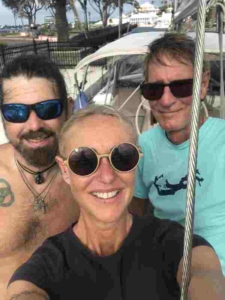 On Sunday afternoon, we picked up Jetty from the airport. After she unpacked and got settled, we went out for dinner in St. George’s—a nice, relaxed way to get to know each other. We all had a good feeling about it.
On Sunday afternoon, we picked up Jetty from the airport. After she unpacked and got settled, we went out for dinner in St. George’s—a nice, relaxed way to get to know each other. We all had a good feeling about it.
The next morning, we got some last-minute fresh supplies, paid the marina fees, and cleared customs. We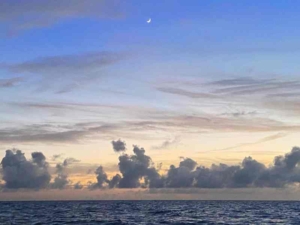 were finally back at sea! A double celebration, because it was also Matt’s birthday—so of course, we made sure to celebrate that.
were finally back at sea! A double celebration, because it was also Matt’s birthday—so of course, we made sure to celebrate that.
The first 24 hours at sea were fantastic. Beautiful wind, great speed, and a perfect night—everyone was happy.
Wednesday, July 10, Position 35:47.191N 60:52.350W
Over the past few days, we’ve had beautiful weather but very little wind. Most of the time, there wasn’t quite enough to sail. At times, with just 5-6 knots on a beam reach, it was barely enough to keep pressure in the sail. We were only making about 3 knots through the water, but thanks to the current, we were doing 4.5-5 knots over the ground—just enough to turn the engine off again.
Then the wind shifted. On a broad reach, we didn’t have enough pressure in the sails, and they were just flapping around. We even tried poling out the genoa, but that didn’t work either.
According to Sven’s weather update, we really need to get to 40°N to find wind. A stationary high is sitting northeast of us, and we need to get above it. So now, we’re heading due north.
By late afternoon, Jetty wanted to go for a swim and managed to convince Matt to join her. I’m not usually a fan of that, but with this kind of “wind,” I figured it was fine.
Instead of swimming, I took a shower once they were back on board. Also refreshing!
Saturday, July 13, position 37:35.917N 56:52.318W
We are making steady progress, though a bit slowly. We have on average about 9 knots of wind and are often on a broad reach. Even when the wind comes somewhat abeam—at 7–8 knots—we still manage about 4.5 knots, which is quite impressive.
In the first few days we were still helped by the Gulf Stream, but now we’re out of it.
It’s a bit of a search for the wind. To our north there is wind, but it comes at over 30 knots—something we wanted to avoid.
An easterly course provided very nice weather and an almost flat sea, but not much wind.
Now the expectation is that north of us there will be no wind at all for the coming days. Well, we’ll see. The advice is to steer a bit north for a day or so and then a few days east.
Depending on the forecasts, we will either make a stop in the Azores to refuel or head for Ireland. Whether we continue west out on the ocean or steer further east into the Irish Sea is a decision for later.
The atmosphere on board is great. We’re enjoying the beautiful weather and stunning starry skies—with equally lovely sunsets and sunrises. In between, there was a clear warm front, and 1.5 days later the cold front passed by.
It turns out Jetty can also play chess—we did that for the first time yesterday. Fun! Especially since I won.
Monday, July 15, position 38:98.458N 49:36.138W
Since this morning we’ve had a nice wind of 15–20 knots, which later even increased to 25 knots. The cross sea was a bit less severe.
We started the day with one furled genoa, but as the waves increased that was no longer an option. So we raised it a bit and unfurled the genoa normally.
In the previous days we had some wind—just enough for sailing—but the speed wasn’t impressive.
We got the advice to primarily steer east since there was absolutely no wind north of us. Essentially, we are now heading for the Azores.
Naturally, the question arises: will we make a stop there? Two arguments made that very attractive, and a third became increasingly compelling.
The last factor was simply the distance. Because of our course, it was becoming less of a detour—now reduced to about 159 nautical miles, basically a day’s sail with some nice wind.
The most important argument was that we now only had half a tank of diesel left. That was rather tight for the 2,300 nautical miles we still had to go to Greenock.
For this reason, I had already decided to make a short stop. And even if we stayed there just one day, it would be a welcome break.
However, there was one drawback… Horta was still roughly 1,000 nautical miles away. With the wind we had now, that would take about 7–8 days—and we’d have to endure that.
The forecasts for tomorrow already indicate that the wind will drop. Wednesday and Thursday should be better… Well, we’ll see in a few days. For now, we’re sticking to this course.
Tuesday, July 16, position 38:90.577N 046:89.250W
Last night was very rough. It started when the wind picked up and the waves grew bigger and bigger, making it impossible to sail wing-on-wing properly. We attempted to furl the genoa that was set on the starboard side and then unfurl it on port.
The furling didn’t go well. Either I let the foot of the sail go too quickly, or Jetty was too slow with the furling line. In any case, the genoa ended up wrapped around the forestay—and we couldn’t get it free.
After more than two hours of struggling on the foredeck in pouring rain with gusts of 25 knots in the dark, we gave up. We simply couldn’t re-roll the top section against the wind.
That top section was flapping wildly, causing the boat to shake and vibrate with an enormous clatter. It wasn’t pleasant at all, and the forestay began swinging excessively. Fortunately, I was able to stabilize it by tightening the lifeline stay.
It was far too dangerous under those conditions to go up the mast, so we decided to call it a day.
It was already 03:00—time for my watch. I stayed on deck while Matt and Jetty went to sleep. Cold and soaked, I spent three hours in the cockpit fighting sleep as one downpour after another hit me. In short, not fun.
After a warm shower and a few hours sleep, we tried everything again in daylight—still without success, unfortunately.
If the wind slackens a bit further and especially if the sea state calms down, I will go up the mast to try to fix it from above.
Thursday, July 18, position 39:52.625N 43:44.529W
We are sailing with full rig again! We managed to free the genoa from its tangle—even without me having to go up the mast.
I was watching from the passage as the top of the genoa rolled around the forestay with the wind and then unfurled a bit until the sheets were wrapped around the forestay in the opposite direction. That was the moment!
I went forward with both sheets and pulled them around the forestay so that the genoa could fully unfurl. It didn’t happen completely on its own, but with some help and pulling, everything came loose and the genoa was free again!
Fortunately, the damage from the flapping was minimal. Only the stitching on the strip that feeds the luff line was loose in several places, and a part of the band itself had already come down earlier.
Anyway, we could really sail again—and that was for the best, otherwise it could have taken a long time before we reached Horta.
It still seemed like it would take a while, as the next morning began as a very grey day with drizzle and virtually no wind.
Thankfully, during the afternoon the sky cleared and the wind picked up again. Meanwhile, Sven had managed to get me the number of the sailmaker in Horta, and they quickly responded to my message asking if they had time to repair the genoa. They did, and if we arrive in Horta they will come and pick up the sail immediately. Nice—one less worry. Thanks, Sven!
In the meantime, it’s a beautiful night again and we still have good wind. Only 675 nautical miles to go.
Saturday, July 20, position 39:00.146N 38:31.750W
The past 24 hours have seen us switching between engine on and off. The wind’s direction has also varied considerably. When we have 7 knots of wind, it’s usually just enough to sail at the same speed as we do under power.
However, it turned out that the new genoa sheets—at least those on port—were quite damaged by the bow of the boom. So much so that we cut off the last 30 cm. We’ll no longer use that boom.
In the meantime, Jetty has announced that she’s going to disembark in Horta. She felt that three weeks was enough—and she also had a few days in Fayal… So she has now been on board for the second time.
Anyway, we hope to arrive in Horta on Tuesday—or otherwise Wednesday morning. We have enough diesel for another 48 hours, so we still need at least a full day of sufficient wind to sail.
Today, at least, is not such a day. It’s only 2 knots of wind right now, and the forecast says it will remain that way. We’ll see. With the engine in overdrive at 1,400 rpm, we’re still achieving a nice speed of over 5.5 knots SOG. Only 465 nautical miles to go.
Monday, July 22, position 38:43.054N 32:17.240W
Over the past two days, the forecasts regarding the wind—or rather, the lack thereof—have been more than accurate.
It’s a bit boring, to be honest. The constant hum of the engine in the background is acceptable, but it doesn’t compare to the soothing sound of just water. On the bright side, we’ve calculated that we’re using less fuel than expected, and we have more than enough to make it all the way to Horta under power if needed.
The monotony of running the engine was brightened a few times by a group of dolphins that swam with us for a while. We were even surprised twice by a small group of pilot whales or Orca’s. They were just too far away to tell, but still.
The lack of wind was accompanied by beautiful weather, both during the day and at night—with equally gorgeous sunrises and sunsets of the sun and moon. I managed to take a few beautiful photos and even a video.
Our to-do list for when we arrive in Horta has meanwhile grown a bit. Since we are sailing east, there is hardly any shade left in the cockpit by late afternoon. The coach roof is then the best place to sit. That’s when we saw a large washer lying next to the mast—a very worrying sign!
It quickly became clear where that came from. The bolt of the gooseneck had come out quite a bit. Further inspection showed that a washer was missing on the inside of the boom. As a result, there was some play, causing the retaining pin in the bolt on the outside to break off. The washer we found had fallen off the outside of the bolt when it came out. We quickly put the bolt back in place, and with some pins and a screw, we managed to secure it for now.
It also appeared that something was wrong with the charging unit. Yesterday, at one point, I noticed that the meter no longer showed any RPMs and the battery voltage had dropped back to 87%—which was odd!
When I stopped the engine to see if a restart would help, the engine wouldn’t start, as if the starting battery were completely dead… Fortunately, there is a switch that allows me to jumpstart the engine from the domestic batteries, and that worked. For a brief moment, the meter showed RPMs again, but they disappeared rather quickly. After about half an hour, the battery voltage was back to 100%.
When I wanted to check the oil today and shut off the engine for that, I had to jumpstart it again to get it going. A query with Vic revealed that the starting battery is new, so that shouldn’t be the issue. Well, I’ll get someone on board in Horta to take a look. Possibly it’s also related to the intermittent functioning of the freezer and the refrigerator.
For now, we still have about 170 nautical miles to go. The end is in sight, with an ETA of somewhere on Wednesday morning.
Thursday, July 25, Horta
We had to motor the final stretch into Horta as well, but we were fortunately entertained by a group of what were probably minke whales that weren’t too far away, amusing themselves by sort of breaching. It didn’t look very graceful, but it did create plenty of splashing.
Another really nice moment was catching our first fish—a Mahi Mahi, just big enough not to throw back. I got to try out my special spike to dispatch it, and it worked quite well. Within fifteen minutes, I had filleted it.
On Wednesday morning around 07:00, we entered the harbor and managed to berth at the fuel pontoon. Check‑in took a little while because the marina manager hadn’t arrived yet, but then everything went very smoothly. It certainly helps if you’re already in the system.
I had arranged with the sailmaker that he would pick up the genoa later in the day from the marina office, and when Matt and I returned from the chandlery that afternoon, it was indeed gone. At the chandlery, I had managed to score a pump for the sink at a reasonable price—a real time‑saver.
We had also brought along a few washers to eliminate the play in the boom. They turned out to be just a bit too thick, but at Peter’s second-hand place we found one that fit perfectly.
Today we did the laundry, took the gas bottle to be refilled, and handled a few other things. The only tasks left are to fill the water tank and pick up some fresh groceries at the supermarket. We’ll do that on Friday together with Claire, who is replacing Jetty.
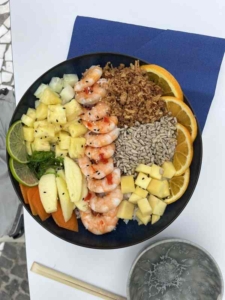 She arrived early in the evening, and to get acquainted we went to dinner at a restaurant that both Matt and I have very fond memories of. That choice was made quickly.
She arrived early in the evening, and to get acquainted we went to dinner at a restaurant that both Matt and I have very fond memories of. That choice was made quickly.
The introduction went very well. Claire is quite experienced and will undoubtedly find her way on board quickly. A nice bonus is that she’s from the Isle of Man and has sailed extensively on the Irish Sea—that’s definitely going to help us.
Saturday, July 27, Position 39:52.325N 28:14.287W
On Friday late afternoon the genoa was delivered. In the meantime, we had the gas bottle refilled, filled the water tank, grabbed our final groceries, and I had checked us out with the authorities.
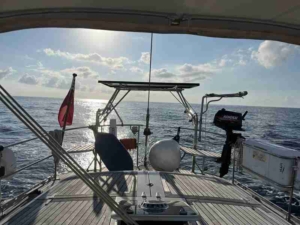 We rigged the genoa up again rather quickly. The weather had cleared nicely, so nothing was stopping us from setting off. And we did.
We rigged the genoa up again rather quickly. The weather had cleared nicely, so nothing was stopping us from setting off. And we did.
The first night went very well. We had a pleasant wind, and with the wind on the beam we were making over 5.5 knots. I took the first watch from 21:00 to 00:00, after which Claire took over. Since she wasn’t yet familiar with the boat, I slept in the cockpit, and when the wind began to pick up after about an hour, we together took a reef—and later even a second reef.
When Matt took over, I went to sleep in my own bed. Toward the end of his watch the wind had decreased considerably and shifted to the northwest.
On the other side of the boat, we then motored and sailed north until we caught the forecasted more westerly wind.
Tuesday, July 30, Position 45:20.842N 26:31.491W
The westerly wind arrived and we could sail again—over 6.5 knots SOG, which wasn’t bad at all! What a relief it was to be able to shut off the engine.
Unfortunately, the fun was rather short-lived. The next morning the wind had completely died down again, and it was back to motoring. We tried again later, but there just wasn’t enough wind.
Sven advised us to keep steering north since east of us lay a no‑wind zone. In fact, if we headed straight for Cork, we’d be right in the boundary between two systems with zero wind.
Well, it’s part of the experience—but in the meantime, we’ve been motoring for three days.
Fortunately, the weather remains good. At times it looks foreboding and gloomy, but then it clears up quite quickly. It’s considerably cooler as we head further north. At night I now wear my sailing trousers with my thin jacket on top—and I might even put on my shoes tonight.
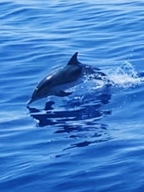
{“key”:”al1pro”}
We saw some more dolphins; most just swam past. We also saw about three that looked like orcas. It was a bit startling, but that odd behavior of slashing their rudders seems to happen only around Portugal. They showed no interest in us and were out of sight again within a few minutes.
Friday August 2, Position 49:35.774N 18:11.549W
For the past few days, we din’t need to start the engine at all. The wind has varied between 12 and 25 knots, and its direction has shifted between WSW and NNW. That gave us plenty to do with sail trim—adjusting with and without the boom, reefing in and then out again.
Last night was different. Yesterday evening the wind shifted back to WSW, and we had a choice: either to bring the boom back in or to drop the mainsail so the genoa could catch all the wind. As the wind picked up a bit, I opted for the latter.
That turned out to be the right choice. The wind increased to over 25 knots, with gusts of 35 knots. On the genoa alone we were making over 7.5 knots SOG. Suddenly, the waves became much higher and came from a slightly different direction than the swell—the effect was a wash that prevented any of us from getting any sleep.
In short, it was a stormy night. I decided to stick to the watch schedule during the day as well, so we could all get some sleep. Thankfully, the weather gods were kinder to us later on.
It’s now much cooler. Earlier, shorts and a T‑shirt were enough during the day, but now it’s long trousers, a windbreaker, and even a hat and shoes. At night it’s full sailing gear—in my case, even boots. During the day it’s variable: sometimes overcast, sometimes the sun is shining brightly. It’s mainly the wind that makes it so chilly.
After the orcas, we saw little besides a small group of lost dolphins. Then, suddenly, we noticed a whole flock of birds. Normally you might see one flying around the boat, but now there were 60–80, as if they were holding their weekly gathering over and on the water. Apparently, there was also a school of sardines or something swimming there.
What’s also rather strange is that for the past two days something has been swimming under the boat with us. It does happen occasionally that the depth sounder suddenly picks up a depth, but this is different. It keeps showing a depth that varies between 20 feet and as little as 1.9 feet—and then suddenly it’s gone again.
It doesn’t seem like something we’ve picked up and are towing with us; that wouldn’t cause such variation. Besides, the sensor is located in front of the keel. It certainly doesn’t feel like we’re towing anything, as the boat’s speed never seems to be affected. It seems more like a school of fish seeking shelter under the boat—but that’s been going on for two days now? That’s very strange. Well, we’ll see… or not, of course.
We’re now roughly at the point where we have to choose: either to sail over the top west of Ireland or to head for Cork and the Irish Sea. I asked Sven what the forecasts are for the coming days, and now we wait.
Monday, August 5, Position 51:44.994N 007:30.146W
Sven’s report was clear: the Irish Sea. It would be very windy, and on the east coast of Ireland there are several marinas to shelter from bad weather—on the west coast, almost none. Moreover, the wind would shift to the west, meaning the west coast would also experience a way bigger swell, while the east coast offers much more protection and the wind there will likely be more southwesterly.
Of course, we took that advice to heart—and it turned out well. The wind picked up to 25–30 knots, and the waves grew as well. It was barely possible to sleep. My new sleeping bag turned out to be rather slippery—I slid all over the cabin no matter how I tried to lie down. Eventually, I managed about an hour of sleep on the saloon couch, more or less.
The wind was expected to persist until Monday afternoon. That was fine because with a south‑southwest wind we could maintain a good course—not comfortable, but fast.
We were supposed to see something of Ireland on Sunday night, even if it were just a lighthouse. But nothing of that sort happened. In the meantime, we had been sailing for over 10 hours along the coast of Ireland without seeing any land.
It was grey, rainy, and dreary. The wind had decreased somewhat as predicted, but the waves continued for a while longer…
If all goes well, tonight around 21:00 we’ll sail into the Irish Sea, with the current in our favor. That’s something here—the current can reach up to 3 knots, and it’s best to have that on your side.
Wednesday, August 7, James Watt Dock, Greenock
We arrived at 12:30. After 47 days, we had covered over 4,600 nautical miles.
The final stretch through the Irish Sea was like a bullet—thanks to the current, which here can reach up to 3 knots, and the wind, which at one point picked up to over 25 knots from the south instead of from the west as forecast.
After not seeing any sign of Ireland for the first two days, the weather cleared up nicely. We even had sun on Tuesday, though it was extremely cold. You’d expect high summer to be a bit more pleasant, but Claire dashed that dream—this is normal for this area… brrr.
It was fortunate that Claire is somewhat familiar with the Irish Sea. The route suggested by Navionics wasn’t the best considering the tide. In the North Channel, we had to follow the starboard side rather than the port side as suggested by Navionics; otherwise, we would have encountered a 3‑knot current.
By Wednesday morning, summer was already over again and the weather turned dreary and grey, with strong winds and, of course, rain. Well, it wasn’t any different. Fortunately, we had chosen the route through the Irish Sea. On top of that, it was one low‑pressure system after another, with winds of force 7–8.
The approach to the marina was a moment of concentration. There was one berth available—albeit alongside—but because of the current, I had to turn the boat on its keel; I didn’t have any extra space. That went completely fine, and what was also very nice was that it was just dry while coming alongside. Once we were secured, it started raining again. No problem, though—we were all tired and in need of a siesta.
When we woke up again, the weather had cleared up a bit, which was very welcome since we had to clean, tidy up, and pack the boat. On Thursday, Claire and Matt were scheduled to depart, and my flight was set for Friday. We celebrated the end of the journey with a very delicious dinner at Scott.
